I thought Twin Peaks: The Return went far deeper than the original series. I wrote this prediction before the premiere about how Twin Peaks: The Return would function:
I expect the new season to be about “Twin Peaks”–not the town, but the show itself. The new season will wrap itself around the old show rather than continuing the plot.
Still, I was expecting The Return to wrap up with a bit more closure than it appeared to. Even though I was sure the end result would be closer to Inland Empire than the original show, I thought Frost’s presence as well as the sheer task of shaping 18 hours of material would require some sort of narrative arc simply to serve as an organizing principle. And it certainly seemed that way until the elliptical and incredibly desolate final episode, which I found viscerally disturbing like nothing else in Lynch’s oeuvre. (Even the three films of his I love, Eraserhead, Mulholland Drive, and Inland Empire, don’t move me like that final episode did; they’re more enveloping aesthetic experiences than emotional ones.)
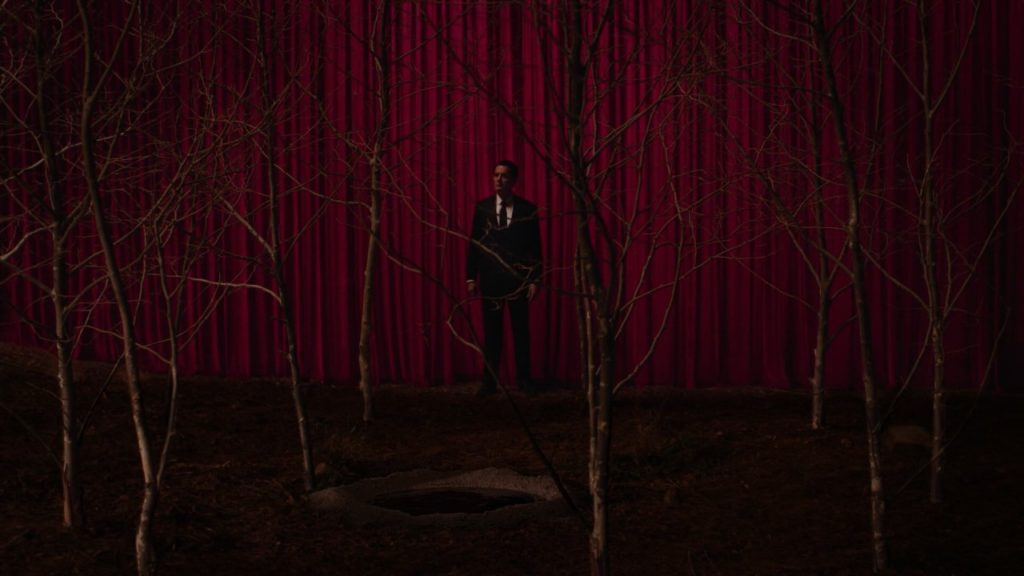
The Curtain Call
The creation of the all-encompassing sense of dread in the absence of any clear rationale or narrative is an awesome achievement. It’s so powerful, particularly the “love” scene between Cooper and Diane, that it demands some attempt at an explanation. This is my best surmise of the kind of submerged material Lynch built episode 18 on top of. My account was inspired by this poster’s key observation that the alternate world of episode 18 was created not by negative entity Judy, but by the White Lodge itself as a trap for Judy. It was the first explanation that began to hint at a reason for the peculiar, overwhelming pathos of the final episode, including the uncanny and unsettling sex scene between Cooper and Diane.
A few things to keep in mind:
- Neither the Doppelganger nor BOB is the primary antagonist of the season. Judy is.
- Judy is or is represented by the Experiment monster, the Mother, horned bug symbols (Jeffries says as much), the Jumping Man, the Chalfonts/Tremonds, and Sarah Palmer.
- Gordon Cole, Garland Briggs, and Cooper have had some kind of longstanding plan to deal with Judy, in partnership with Phillip Jeffries and MIKE.
- Twin Peaks: The Return has a symmetrical structure. For example, Cooper enters catatonic Dougie-state 2.5 hours in and wakes up with 2.5 hours to go.
- Black Lodge creatures, including Judy, are attracted to pain and sorrow, a.k.a. garmonbozia, and consume it.
- Electricity is a fundamental energy, like fire.
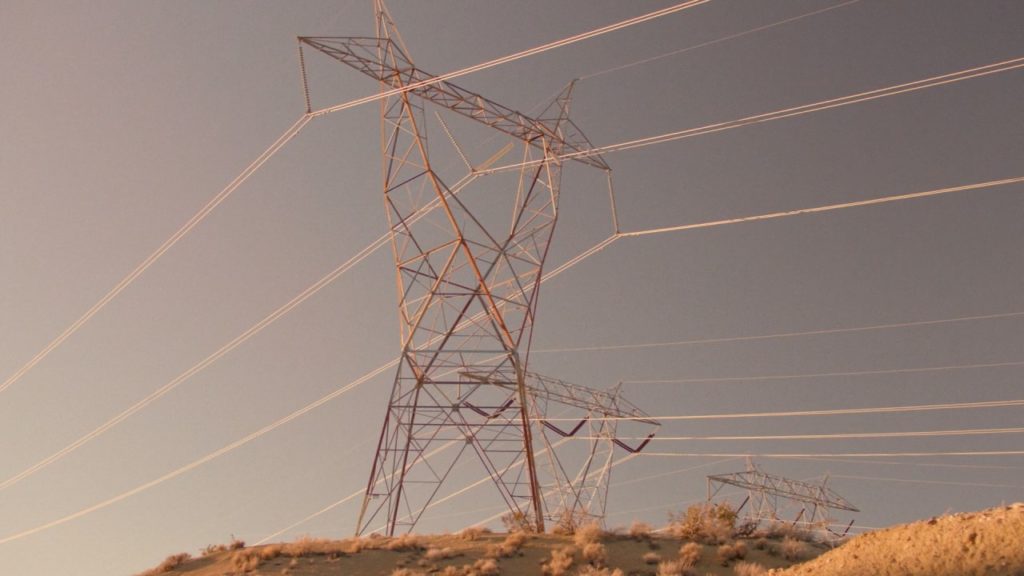
Electricity
Here is my best guess at the plan to deal with Judy, and the terrible costs associated with it. None of this is meant to be definitive, just an approximation of something I find compelling, and perhaps an approximation of what Frost in particular had in mind before Lynch started improvising over it.
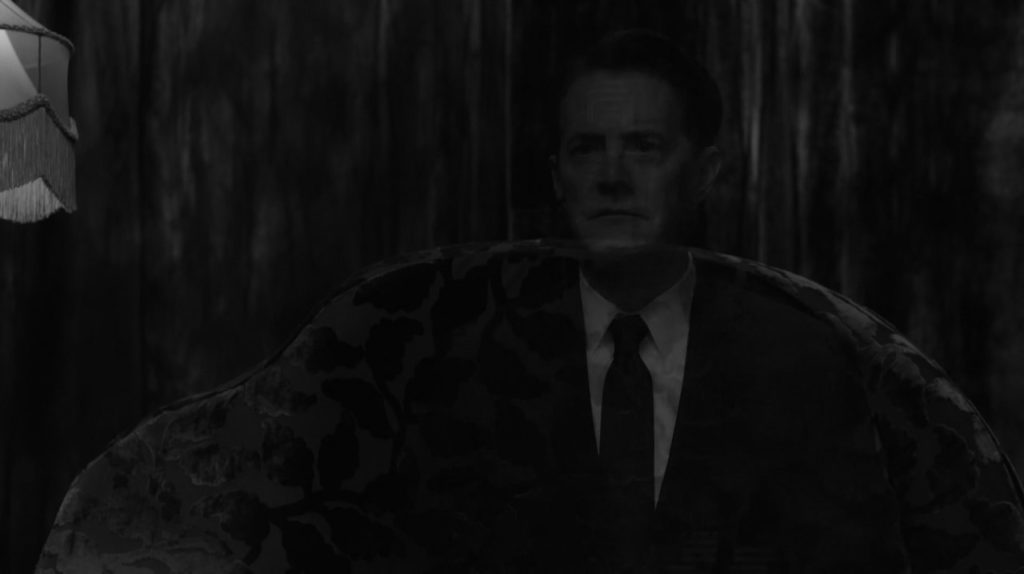
“You are far away.”
The Fireman tells Cooper in the very first scene, “It is in our house now.” The “it” is Judy and her Black Lodge denizens. The Fireman is never more serious than he is here. This is a very, very bad thing, requiring desperate measures. He then gives Cooper three reminders: 430 [miles to the crossover into the alternate reality], Richard and Linda [Cooper and Diane’s alter egos], and “Two birds with one stone” [Cooper’s plan]. The timing of this scene is ambiguous. It may take place after Cooper electrocutes himself back into sentience in episode 15, but it’s more important that Cooper remembers it after that point, and knows what he has to do.
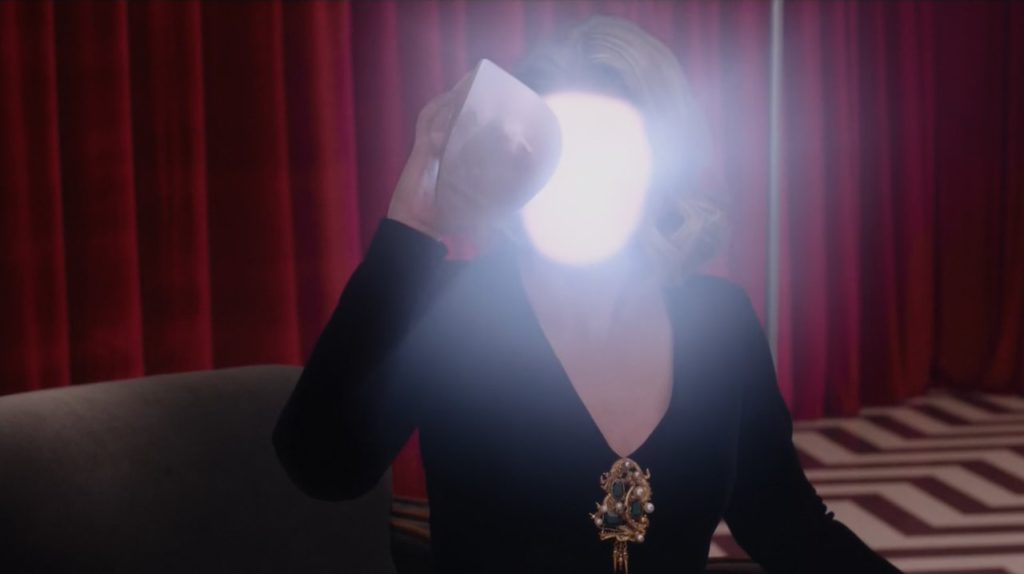
The Bomb
The trap has three key elements:
- The Cage: a pocket dreamworld created by the White Lodge, containing Odessa, Texas and Twin Peaks
- The Lure: Cooper and Diane
- The Bomb: Laura Palmer
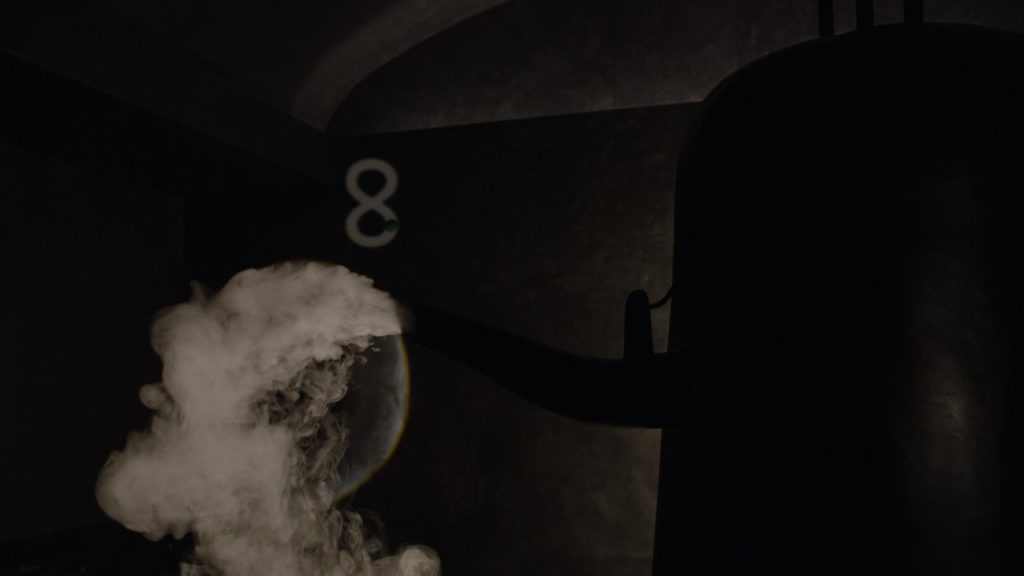
“It’s slippery in here.”
With Phillip Jeffries as travel agent, Cooper goes back in time to rescue Laura Palmer on the night of her death. He tells her, “We’re going home,” in a funny and not terribly reassuring tone of voice. If “home” means the home of her parents, it is about the last place Laura would want to go. In fact, “home” is the White Lodge, where Laura originated in episode 8. Cooper takes Laura to the Jackrabbit’s Palace White Lodge grove. The sound the Fireman played for Cooper is heard just as Laura Palmer disappears, screaming as she does. This signals that the White Lodge has picked her up. Cooper is not especially surprised at her disappearance. He looks up because she has been pulled up, as she was from the Red Room in episode 2 (with the same fluttering noise). Up is the direction to the White Lodge.
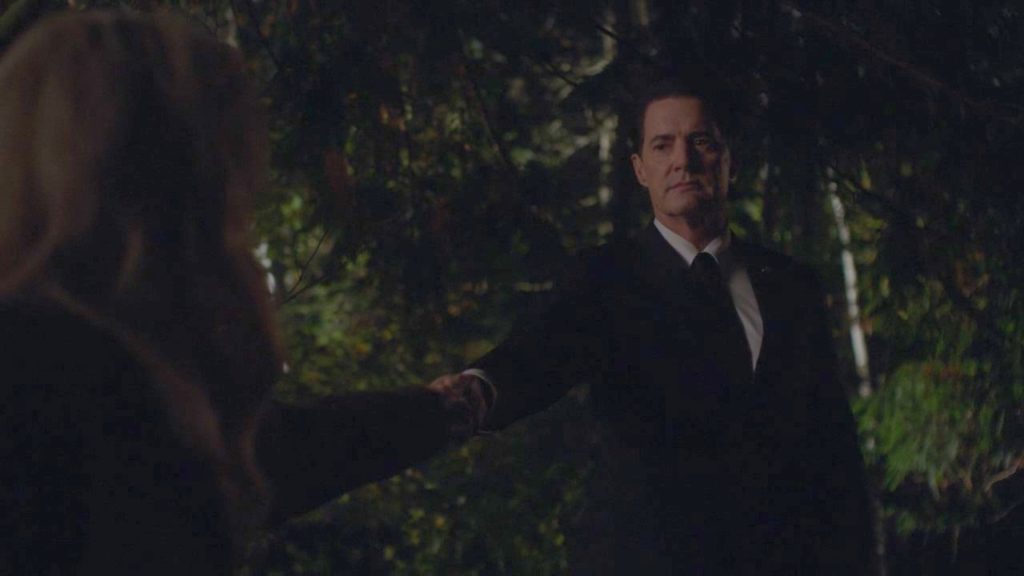
“We’re going home.”
Sarah, acting under the influence of Judy, is infuriated by Laura’s disappearance and tries to smash her picture, but the scene keeps rewinding and the picture is invulnerable. This reality is becoming the “unofficial version” and Laura is “saved.”
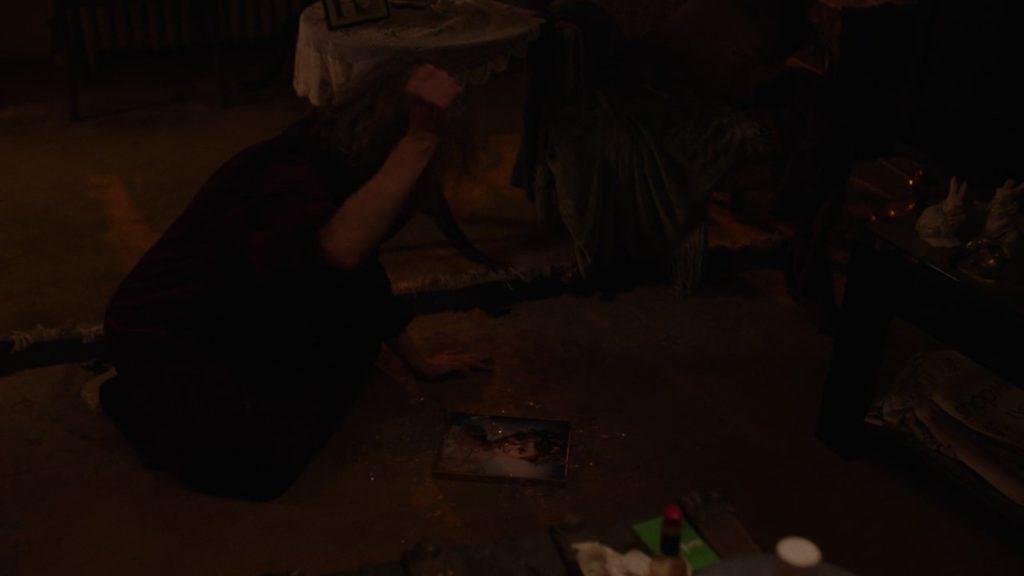
Homecoming
The White Lodge does “save” Laura from death at her father’s hands, but that’s not Cooper’s purpose, which is why he seems increasingly dour after leaving the sheriff’s station. Laura is being put to use in the trap for the greater good, but not for her own good. She has still suffered a terrible childhood and adolescence full of abuse. In Fire Walk With Me, Cooper told Laura not to take the owl cave ring because Cooper’s plan requires Laura alive. When Leland/BOB killed Laura, it messed up the plan.
If Cooper were primarily concerned with truly saving Laura, why didn’t he rescue her from the past years before the night of her death, in order to spare her so much terrible abuse? Ironically, the tragedy of Laura Palmer is that no one wanted her to die, yet everyone caused her to suffer—the revelation of episode 18 is that her tormentors now include Cooper among them. In The Return, “Who killed Laura Palmer?” ultimately becomes the MacGuffin Lynch and Frost originally intended it to be. The question “Who killed Laura Palmer?” led both characters and viewers astray, distracting from the more important and more compassionate question, “Who—or what—is Laura Palmer?”
The White Lodge deposits 1989 Laura into a pocket dreamworld, which I’ll just call the Cage. We already saw the White Lodge use a cage to contain Mr. C briefly; that is a hint as to the nature of this dreamworld. It shapes itself around her. Laura then stays in the Cage for 25 years, living out a mostly uneventful life as Carrie Page in Odessa, Texas.
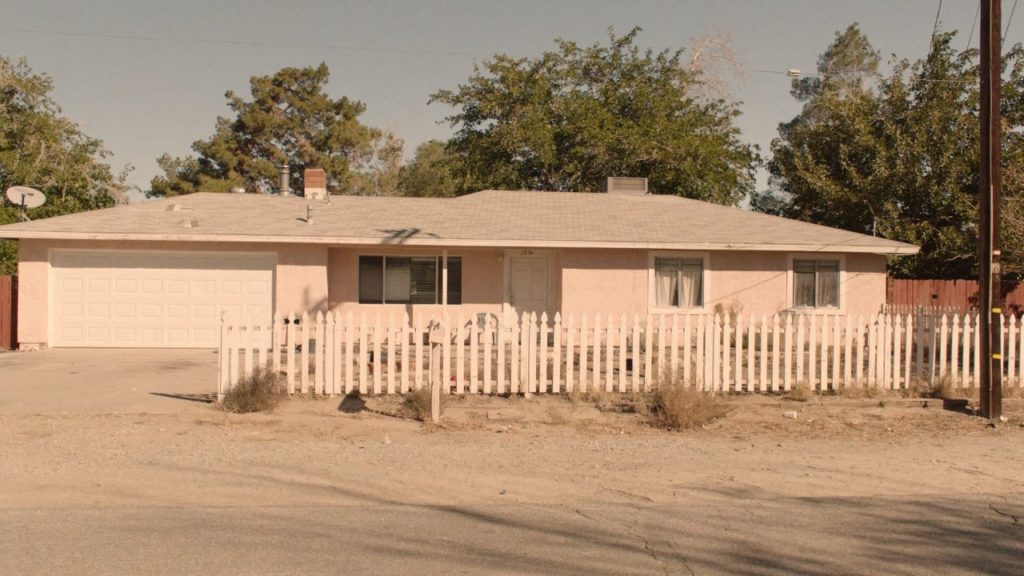
Odessa, TX, Pop. Pylon
Laura’s subsequent life as Carrie Page appears to have been better than her childhood, judging by what little we learn of her, but there is still a dead body in her living room when Cooper shows up. The Cage is, perhaps, Laura’s dream of the life she hoped to have if she could escape her childhood. By entering the Cage, she forgets much of what happened prior to entering it.
The Cage is not Judy’s domain. It is a White Lodge creation given shape by Laura’s own dreams. The jackrabbit is the symbol of Odessa. The Fireman knew of the Cage by the time Andy took his trip into the White Lodge: he showed Andy a picture of the #6 pylon outside Carrie Page’s house. The Fireman is conscious of the plan and an accomplice to it.
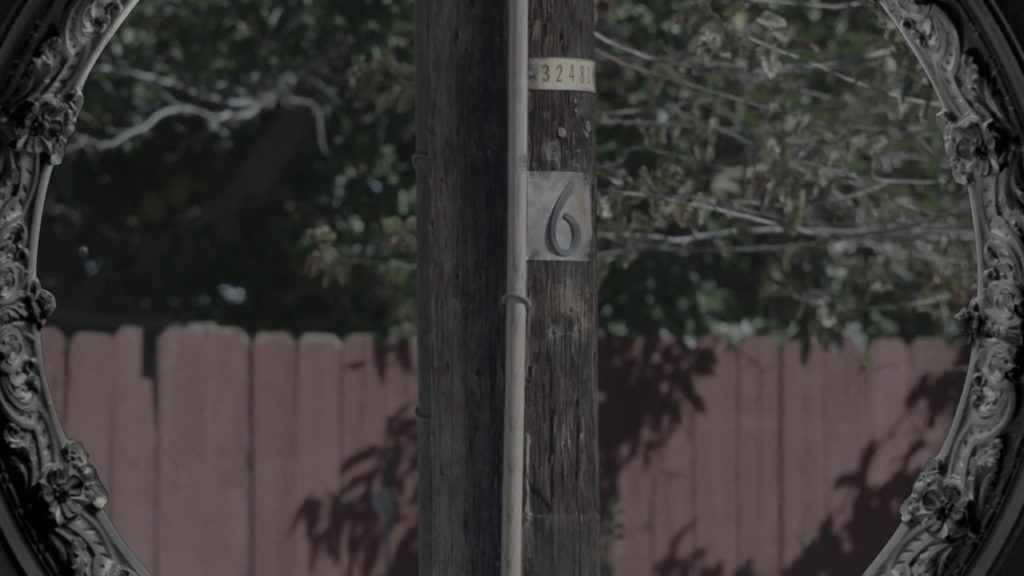
Fireman-o-vision
“Laura is the one,” but why? When the Fireman sent the golden Laura orb down to Earth in response to the Trinity nuclear test, I and others worried that this might change Laura from a fully human survivor of abuse into some sort of magical chosen one, dampening the human element of the show. I now think that Laura is special, but she is special because of her pain. Laura lives through a horrendously dark youth. The psychic residue left by her abuse at the hands of her father and BOB is so tremendous that Judy makes the Palmer house her base of operations, either inhabiting or possessing Sarah Palmer. BOB was a garmonbozia glutton, and Laura was an everlasting gobstopper of garmonbozia, until she died (an outcome which BOB/Leland did not want). The Black Lodge consumes garmonbozia, but cannot generate it independently.
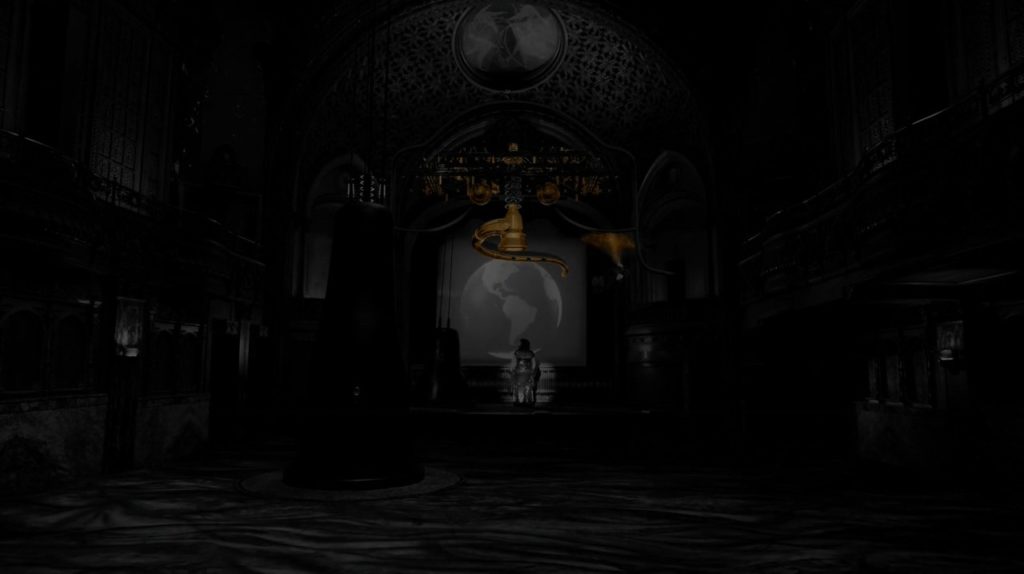
Deployment
Why would the Fireman, portrayed as a positive figure, create such a martyr figure? I suggest that Laura Palmer was meant to function as a capacitor: storing a huge accumulated charge of suffering which could then be discharged at the precise moment. Laura’s immense suffering does not make her superhuman, but it makes her uniquely capable of serving a purpose in the Trap. In the right setting, this discharge could overload the circuits of a Lodge entity and destroy it altogether. To use another apt analogy, it would be like an atomic bomb reaching critical mass. But with fissionable material as substantial as Judy, you would not want to detonate it in our universe, or else it would take most of our world with it.
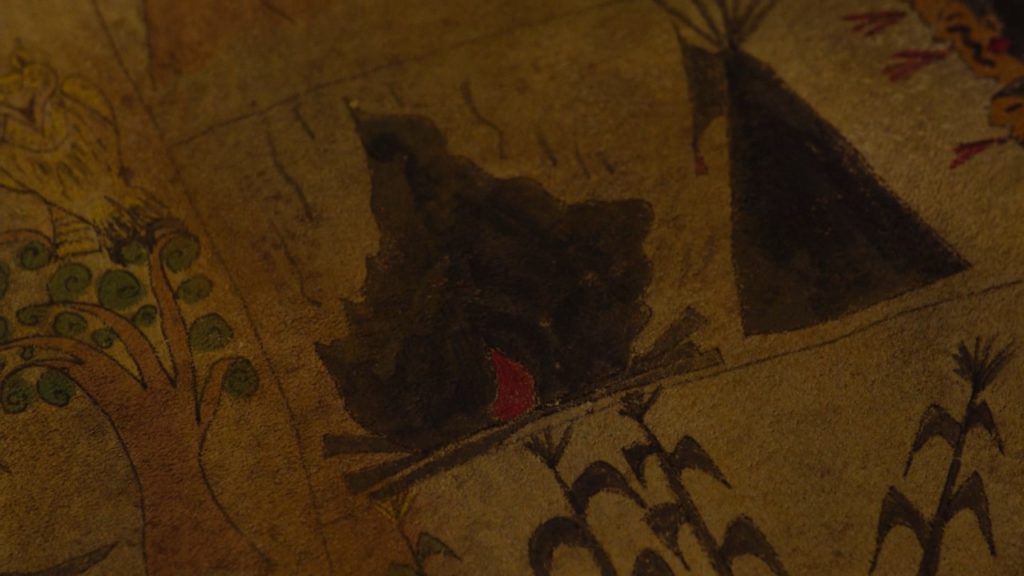
Judy’s Life-force
In the language of Hawk’s map:
- Laura is the highly-concentrated pure corn (of fertility) that becomes diseased black corn (garmonbozia) through suffering.
- Black Lodge beings consume garmonbozia to generate black fire/electricity (which smells like scorched engine oil).
- Judy is the powerful mother of corrupted fertility, capable of consuming unearthly amounts of garmonbozia to feed her immense black flame.
- Given sufficient black corn (i.e., fuel), the black fire will grow, consume everything, and burn itself out, like pouring gasoline on a fire. Or an electrical circuit overloading. Or an atomic bomb reaching critical mass.
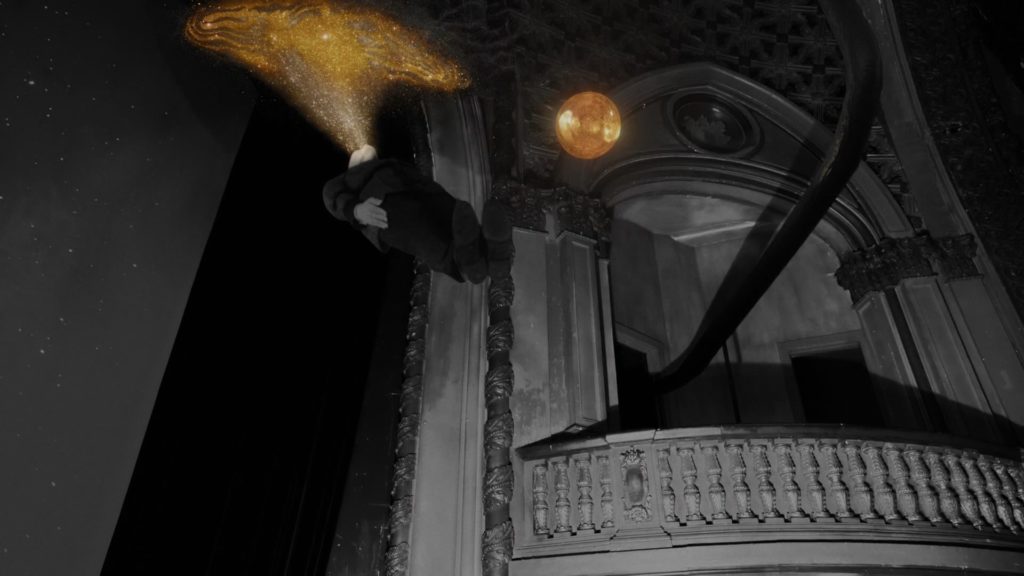
Highly concentrated, highly flammable, but still too pure
Gold is the color of garmonbozia, and of Laura’s orb. As generated by the Fireman, she is super-infused with corn—she is highly potent fuel. But Judy will not feed on good, healthy corn. Only black corn will do. Leland and BOB had to take care of that corruption. When the Fireman freezes the picture on the shot of the BOB orb emerging from Judy, it is not because he sees BOB as the central threat (though at this point in the series, the viewer is supposed to think so). It’s because BOB is unwittingly part of the plan to defeat Judy.
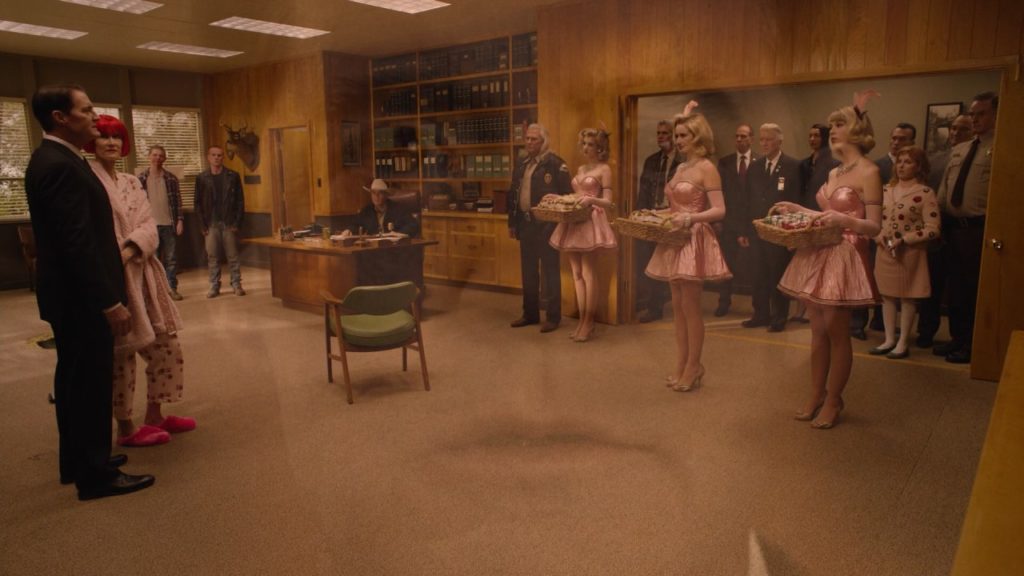
“There are some things that will change.”
Meanwhile, 25 years later, in the regular universe: the Fireman diverts Mr. C from Sarah’s house (Twin Peaks’ most negative location) to the sheriff’s station (Twin Peaks’ most positive location). Mr. C sought garmonbozia and so was drawn to Sarah Palmer, but he was being set up by Jeffries and Briggs all along. His plotline isn’t crucial to the Trap, which is why his defeat came so easily with the aid of a hastily-recruited English kid with a superpowered glove. He did some damage, but Cooper-as-Dougie was untouchable due to White Lodge management. Mr. C kept BOB fed with garmonbozia after Laura’s death, but that danger was fairly minimal compared to the apocalyptic threat posed by Judy, so that Mr. C didn’t even show up on Gordon and Albert’s radar until 2016, and Gordon is fairly indifferent when Mr. C escapes from prison. (Given Ray’s status as an informant and Gordon’s connections to Phillip Jeffries, it is easily possible Gordon was in on the escape plan.) Gordon is rather Machiavellian and callous when it comes to the suffering of others. He may have gone soft on Diane’s tulpa, but he’s not soft where it counts. The anger Diane’s tulpa felt toward Gordon and the FBI is real and justified. She’s being used by them.
When the clock locks on 2:53, it signals the completion of this world’s story, which will soon become the “unofficial version.” As the Log Lady said, “The glow is dying…the circle is almost complete.” 2 + 5 + 3 = 10, “the number of completion.” Diane and Cooper, who have both traveled outside of this story, move on to the final act along with Gordon, who possesses some sort of special powers himself.
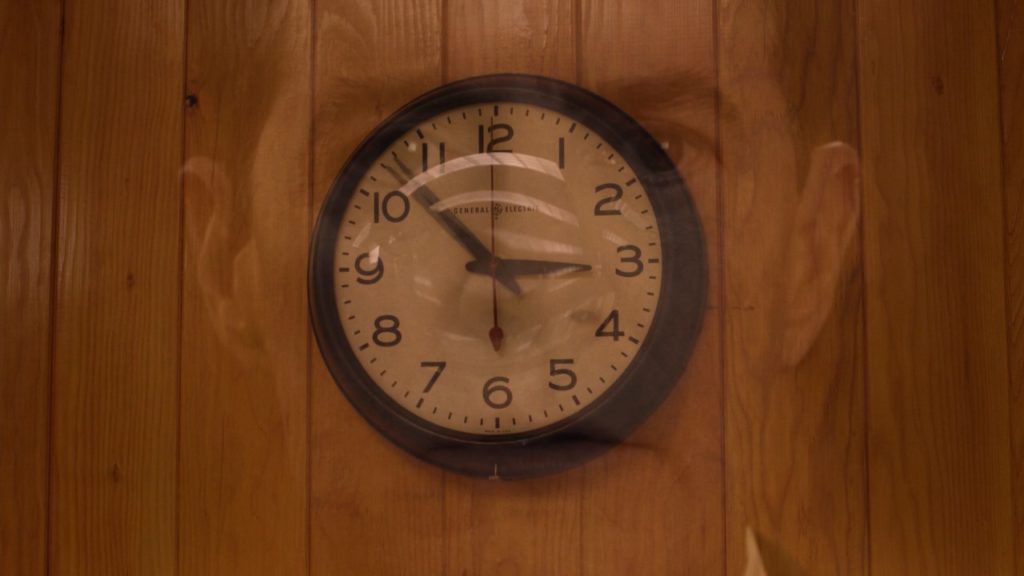
2:53 Sunday, October 2
In between leaving the sheriff’s station and going to the basement of the Great Northern, Cooper, Gordon, and Diane formulate the solution to a problem with the plan. (Gordon also gives Cooper a replacement FBI pin.) Part of the plan, which involves rescuing Laura from the past, is still fine. The problem is that after being deposited in the Cage in 1989, Laura makes poor bait, because once in the Cage, she forgets her childhood, and so Judy is not lured into the Cage. That task falls to Cooper and Diane. Cooper, having already made use of Laura in the Trap, is also going to sacrifice himself and Diane to it.
Cooper takes another trip through the Red Room, similar but different from the path he took in episode two. He has crossed over into the new “official version.” The doppelgangers are gone, because they were not created in this version. More subtly, Laura is missing from the initial “Is it future or is it past?” scene with MIKE. The camera focuses on the empty chair where Laura sat in the first iteration. When we do see Laura, after Cooper speaks to the Arm, it is in fact Cooper’s memory of the first trip. We don’t see Cooper sit down or stand up, and the whole scene is abbreviated. The Laura Red Room scene in episode 18 is a flashback prompted by the Arm, to remind Cooper of his mission. Laura herself is sealed off in the Cage, and has been for many years.
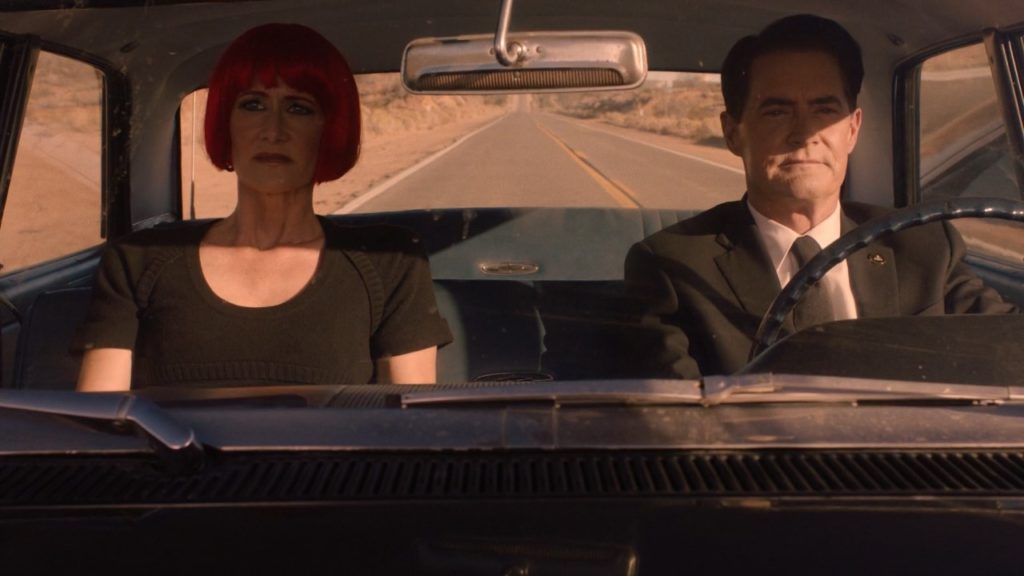
“You don’t know what it’s going to be like.”
Cooper exits via Glastonbury Grove and meets Diane in the official version. We do not hear them speaking of the plan, but we know they aren’t certain what they will find in the Cage, and that Diane is nervous, while Cooper is resolute but joyless. They drive a rickety 70s-vintage car because they do expect to find a world stuck in 1989 or even earlier, because they will be entering Laura’s dreamworld. They enter a mysterious, empty world, and arrive at a motel with 80s-era fixtures: a rotary phone, CRT television, and old-fashioned locks. They check in and have disturbing, passionless sex.
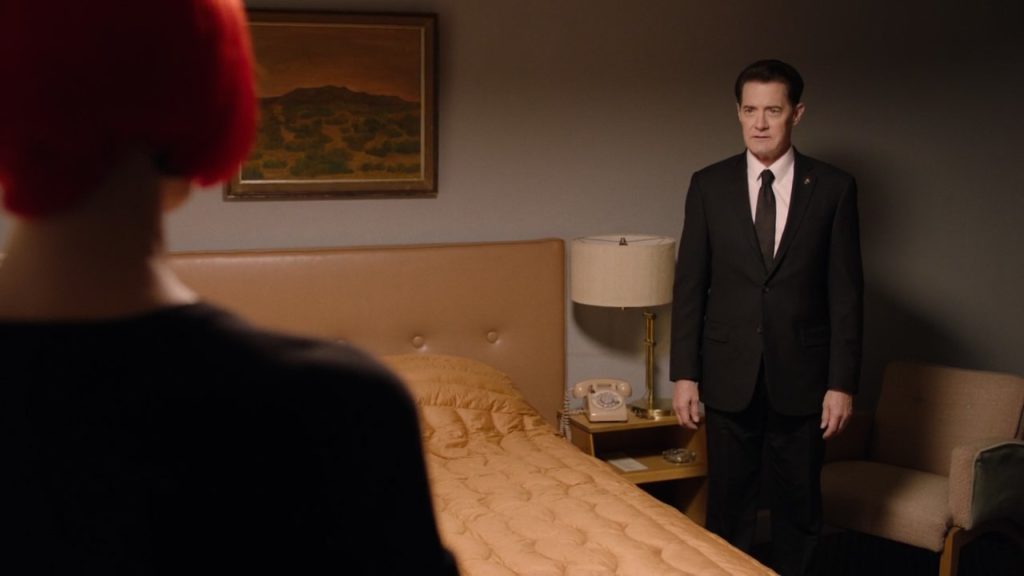
“Turn off the light.”
This is where a symmetry with episode 1 comes in. I take the Experiment to be either Judy or an avatar of Judy. Sam and Tracey appeared to draw the Experiment to them by having sex (sex is almost always bad in Lynch films), whereupon the Experiment brutally slaughtered them at the height of their fear. Diane and Cooper now reenact this summoning ritual in order to draw Judy into the Cage. They both know this is the plan; while they both care for and love each other, this act of sex is anything but an act of love. Both are joyless. Cooper is dispassionate throughout, but remains focused on Diane with an expression of restrained concern. Diane tries to be affectionate but collapses into terror and tears, covering Cooper’s face and staring up at the ceiling.
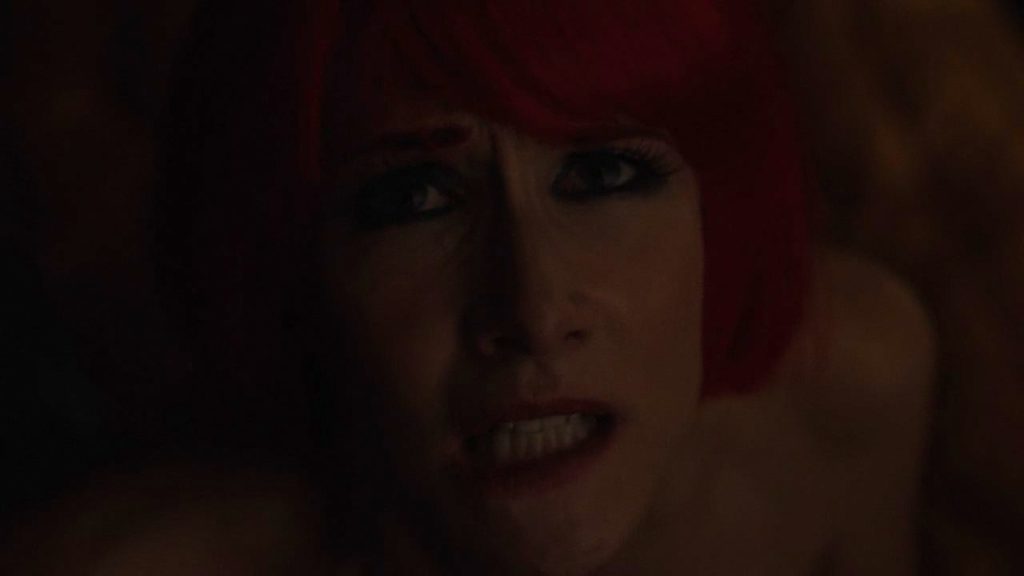
None of this is unexpected to them. This was the plan all along. The suffering that Diane (and to a lesser extent Cooper) endures is a product of her having sex with the man who raped her. She knows it is going to be a traumatic experience: she sees her double outside of the motel because she is already dissociating at the prospect of having to sleep with Cooper, even though he’s not that Cooper. Cooper tells her to turn out the light in the hopes of sparing her some of the trauma, but it’s an empty gesture. He is guilt-ridden with the sins of his doppelganger. Their trauma helps lure Judy, but it is also what keeps them alive. Sam and Tracey were killed because they weren’t generating enough garmonbozia, so the Experiment mauled them to death to feast on their terror. But like Laura, good garmonbozia generators are worth keeping alive, so Judy does not kill Diane and Cooper. She enters the Cage to the tune of the Platters’ “My Prayer,” which also heralded Judy’s arrival by way of frog-bug in episode 8, but she leaves Diane and Cooper alive—or at least Cooper.
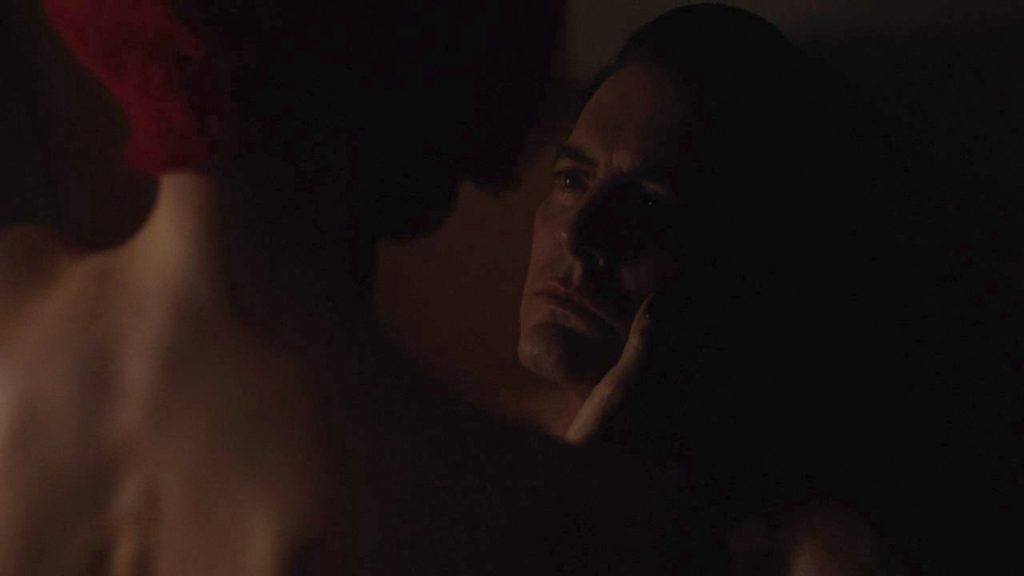
The disturbing nature of Diane and Cooper’s sex stems, ultimately, from two people violating every instinct of humanity, compassion, and love they possess in pursuit of an abstract greater good. In particular it stems from Cooper using Diane—with her consent, admittedly—as a means to an end in a brutally inhumane fashion. Cooper rarely had to choose between duty and instinct prior to now; they always pointed him in the same direction. Now they are completely incompatible.
The unnerving, pervasive desolation of this Cage dreamworld is a product of its being shaped by (a) Laura’s own traumatic history, (b) Judy’s malevolent influence, and (c) Cooper and (to a lesser extent) Diane’s horror at the task they are undertaking. Nothing good will come of anything in the Cage dreamworld. Any beneficial effects will be to the other world, which is of little emotional comfort to the people now stuck in the Cage. But the oppressive desolation may only add to the combustibility of the Laura-Judy garmonbozia megabomb.
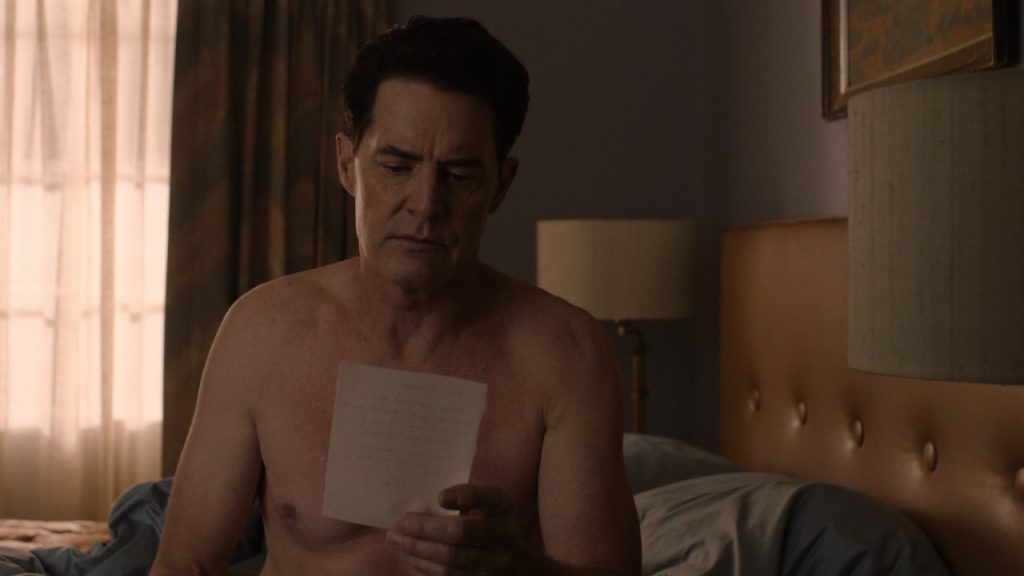
Richard and Linda
The dreamworld is remade overnight due to some combination of (a) Judy’s presence, (b) Cooper and Diane’s presence, and (c) the Cage being shut. The world outside updates itself to the present-day, including Cooper’s car. Andreas Schou points out that Cooper’s car turns into the identical model that Mr. C was driving in episode 3 during his 2:53 car crash, indicating the assertion of the darker side of Cooper’s personality as well as Judy’s increasing influence over the Cage.
Cooper and Diane’s lives are rewritten as Richard and Linda’s. They are still the same souls, but their memories have been smeared and corrupted, as Carrie Page’s have been. Diane dissolves into Linda and leaves Richard, not knowing exactly what has going wrong but knowing she cannot face Richard anymore. (It is possible, on the other hand, that Judy simply consumed her, as Diane’s suffering was far greater than Cooper’s.) Cooper, who has a stronger will than Diane or Laura, hangs on to his past self, but when he reads the letter he knows he has sacrificed the person he cares for most in the world, Diane, to his plan. Diane may have been a willing accomplice, but the responsibility ultimately falls to him, and he is devastated. None of them were going to get out of the Cage alive, but Cooper is still devastated by Diane’s trauma and disappearance. He is very nearly broken by it, unable to enjoy coffee and closer to letting his dark side out than he ever has been before. The events of the first two seasons were child’s play next to this.
Once in the Cage, Judy takes up residence in a familiar place of pain: the Palmer residence in Twin Peaks. That’s unlikely to be the extent of her influence. She leaves white horse totems outside the diner and inside Carrie’s house. Judy may recognize Carrie as Laura, or at least as a rich supply of garmonbozia. Perhaps she leaves the #6 electrical pylon in place next to Carrie’s house to harvest garmonbozia, just as it harvested garmonbozia from the dead boy in episode 6. Perhaps it’s already siphoning a bit of garmonbozia as a result of the dead body in Carrie’s living room. Perhaps the events of Carrie’s last three days off work are a result of Judy’s malevolent influence newly suffusing the Cage.
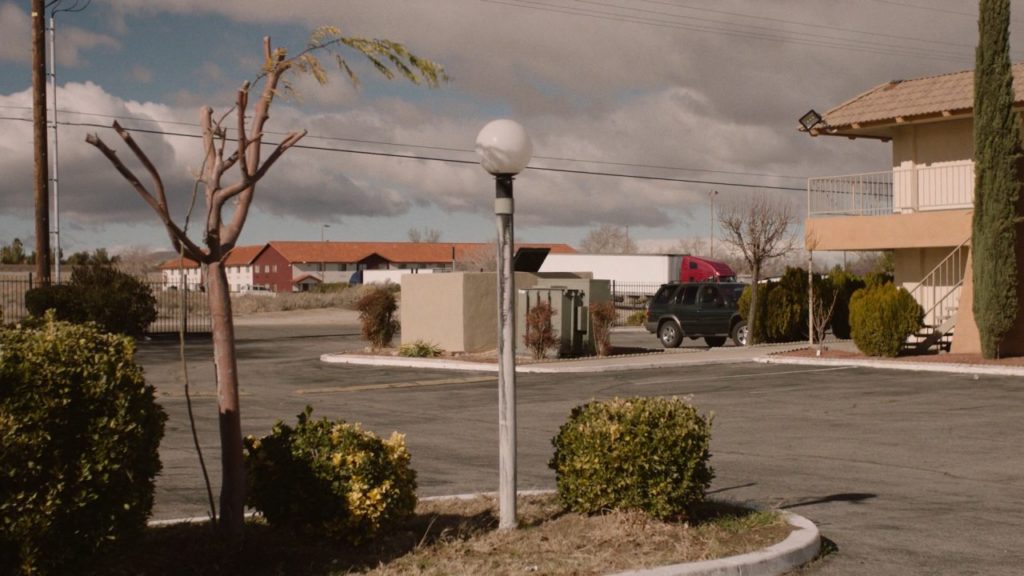
Two familiar friends outside the new motel: the Evolution of the Arm and the Fireman (echoing the White Lodge’s standing lamps).
Exiting from a different motel than the one he checked into, Cooper remembers his task and joylessly goes about it, though he starts to lose track of himself. He focuses his mind on a single task: bring Laura to Sarah Palmer (who is Judy). He knows that Carrie Page needs to remember her horrible life as Laura in order for her to function as a bomb. She doesn’t. He still sees the Cage to be unreal, so he ignores the dead man in her living room, and is fairly callous with the people at the restaurant. They drive down very dark highways to Twin Peaks. Who knows how much of the rest of the world is even filled in? The world is not just disenchanted but empty: when they stop at the Valero gas station, there is no traffic at all until they start the car to drive again. The world only seems to exist immediately around them.
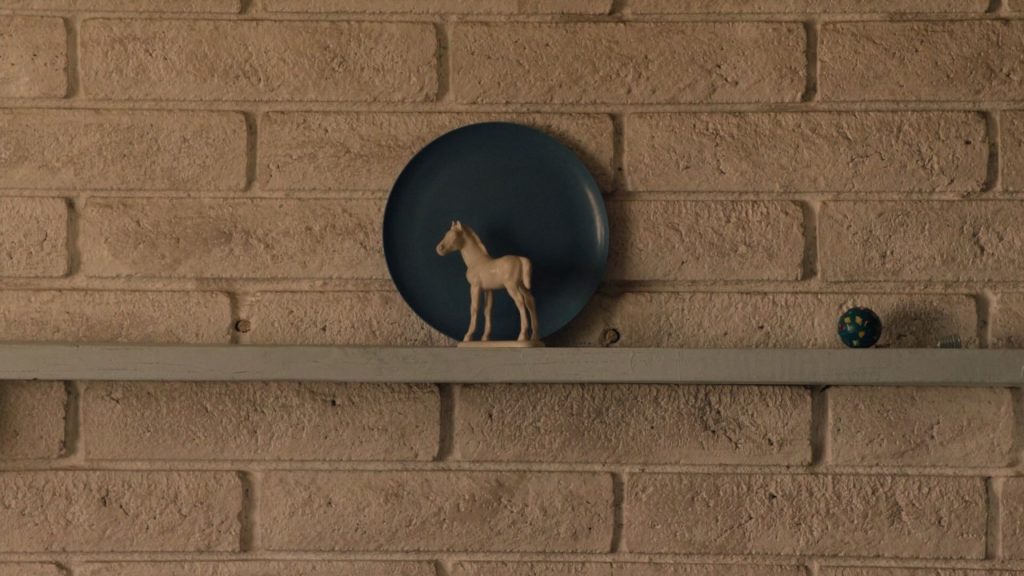
A totem of Judy’s presence
Some familiar things remain in the Cage. Twin Peaks will exist because it remains in Laura’s memory. They pass by the RR diner, which no longer has the RR2GO sign because neither Laura nor Cooper had any knowledge of it. Cooper thinks that Sarah Palmer will be living in the Palmer house and that Sarah will shock her into remembering. When they get to the Palmer house, he’s baffled that there is no record of the Palmers living there. Who else could be living there, if this world was shaped by Laura? The answer is Judy. The names Tremond and Chalfont stir vague memories in him, but the Cage is confusing him as well. He may well have forgotten about Diane by this point. Judy’s influence may be corrupting things as well. The Cage has been closed to make certain Judy cannot escape.
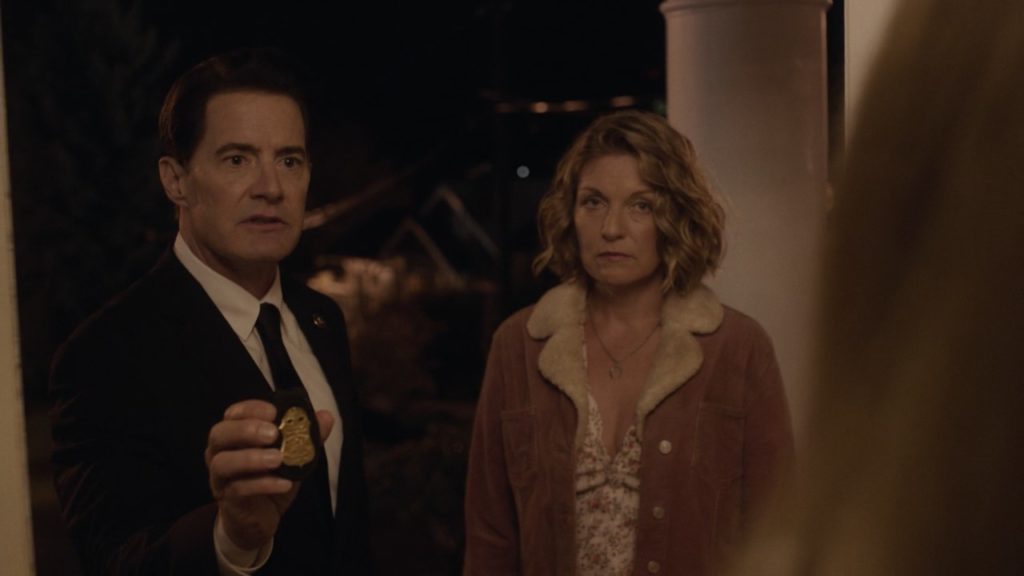
“I’m Special Agent Dale Cooper. What is your name?”
Cooper paces, confused, trying to hold on to his thoughts. “What year is this?” he asks, as one might ask one’s self in a dream. This stirs something in Laura, some knowledge of the Cage’s unreality, and it is enough so that Judy calls out to her in Sarah’s voice. At this point, Laura does remember, and she knows what she needs to do as well. It is possible that she has full knowledge of her role in the Trap. The collective weight of her past returns and she lets out a tremendous, violent shriek, discharging all her suffering within the confines of the Cage. The bomb explodes.
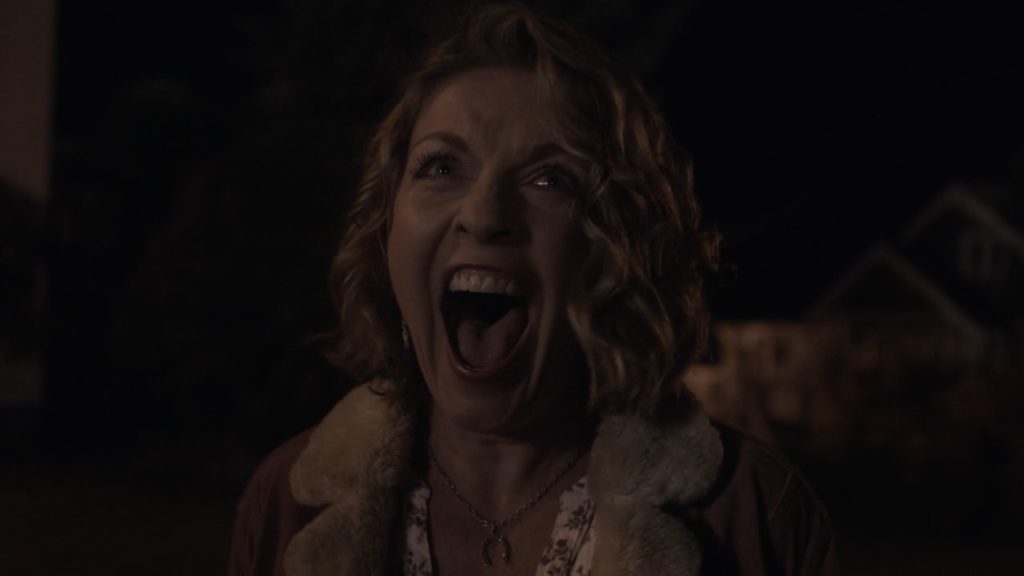
Discharge and detonation
The lights in the Palmer house overload and blow out. The electricity stops. The screen goes black and the scream dissolves into an echo and fades away. Judy is destroyed along with everything else in the Cage. The plan worked. “It” entered our house at the very beginning of episode 1 and exited at the very end of episode 18. The daughter’s trauma, caused by her father, destroys her mother.
Not coincidentally, Laura, Cooper, and Sarah Palmer are the three characters who have seen the white horse. The Log Lady said, “Woe to the ones who behold the pale horse.” All three are destroyed in the blast.
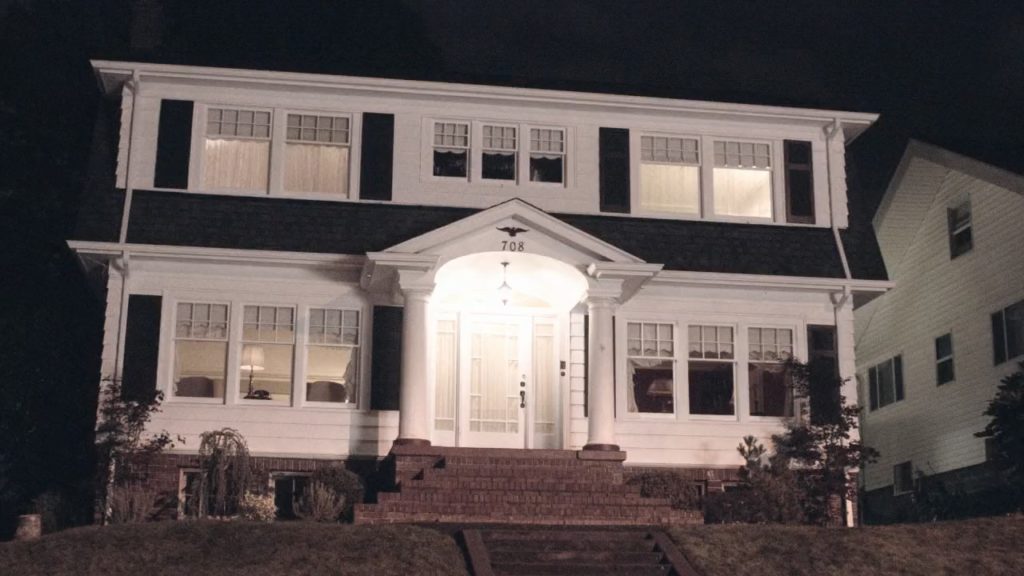
Power surge
Meanwhile: Leland, possessed by BOB, went on doing his thing after Laura disappeared off the face of the planet the night she was supposed to have died. Gordon remembers “the unofficial version” where Laura died, but he knows it was the right call and is not too bothered. Most of Twin Peaks: Fire Walk With Me happened. Most everything else didn’t—which has implications for a lot of what happened in The Return. Mr. C and Richard Horne never existed in the “official version”…but neither did Douglas Jones (in any of his three incarnations) or Sonny Jim, the son who needed a sunny gym. Cooper sacrifices not only his own self and his true confidante Diane, but also his two children. The Oz-like fairy tale of Las Vegas and the noir nightmare of Buckhorn become the unofficial “dreams” of their respective Coopers.
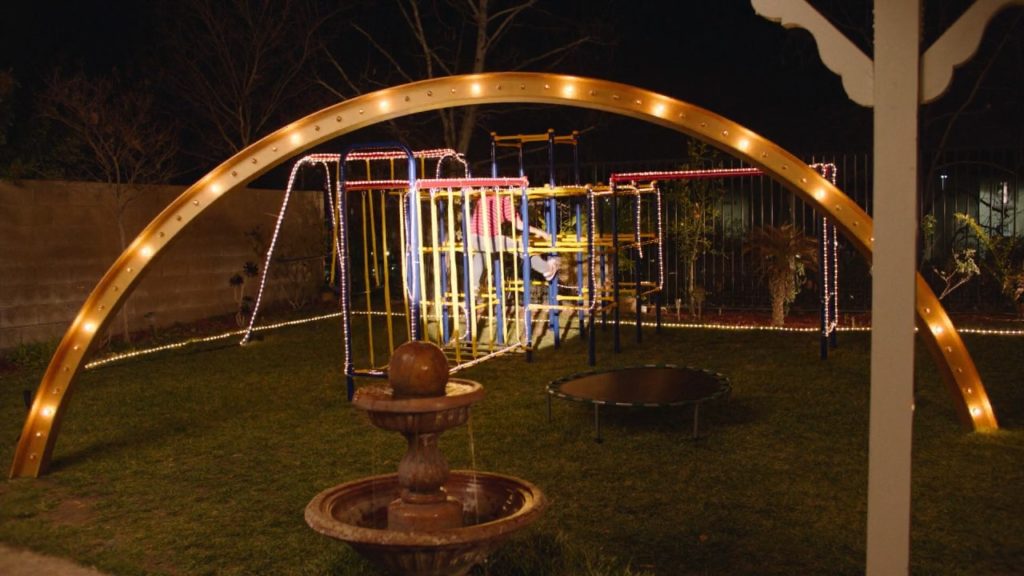
The fairy tale
The fairy tale “wins” out over the noir in episode 17 (the previously untouchable Hutch and Chantal die easily as soon as they enter Dougie’s sphere of influence), but the resulting world “loses” out to the remade “official version” in which none of it happened. This hauntingly evokes Franz Kafka’s parable, “On Parables”:
A man once said: If you only followed the parables you yourselves would become parables and with that rid yourself of all your daily cares.
Another said: I bet that is also a parable.
The first said: You have won.
The second said: But unfortunately only in parable.
The first said: No, in reality: in parable you have lost.
In reality, Cooper wins—but he is no longer part of reality. He became a parable. He joins the ranks of Philip Jeffries and Chet Desmond, more legend than reality.
(This rewriting of history, however, may set up a Mobius-strip time loop in which the two versions oscillate, but I find that much less interesting than the horrible compromise Cooper has to make to make the Trap work, and what it does to our conception of his character, and particularly the impossibility of his character.)
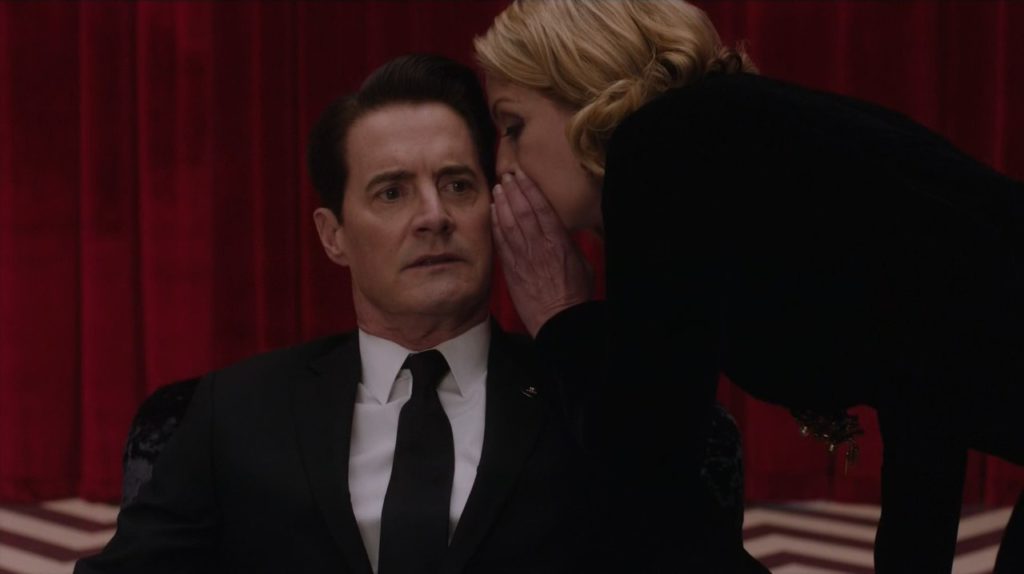
And that leaves two speculations. First, the stone was Laura Palmer, and the two birds were Judy and BOB. (Cooper only hit one bird, since BOB was only wiped out in the “unofficial version.”) Second, Laura’s spirit (not necessarily Laura herself) whispered something like this to Cooper in episode 2: “You will use Diane and me to lure Judy into a trap where we will all die.” Or, “We are the dreamers who will die in our dream.” Or maybe something as simple as, “You will kill me.” In keeping with the symmetrical shape of The Return, Laura whispers to Cooper 80 minutes in, while Cooper “saves” Laura with 80 minutes remaining.
One last thought: anyone who could come up with such a cruel plan, no matter how beneficial, must have a very serious dark side. Cooper lost this dark side when his doppelganger was created in the Black Lodge. His soul was, if not annihilated, at least dis-integrated. Cooper’s shadow self was reintegrated with him the moment the doppelganger burned. Cooper needed his shadow self because of the darkness of his task. Dougie-level goodness alone is not sufficient to defeat Judy. I believe, in fact, that the controlled possession of his shadow self was necessary for him to open the curtain out of the Black Lodge that he was blocked from exiting in episode 2.
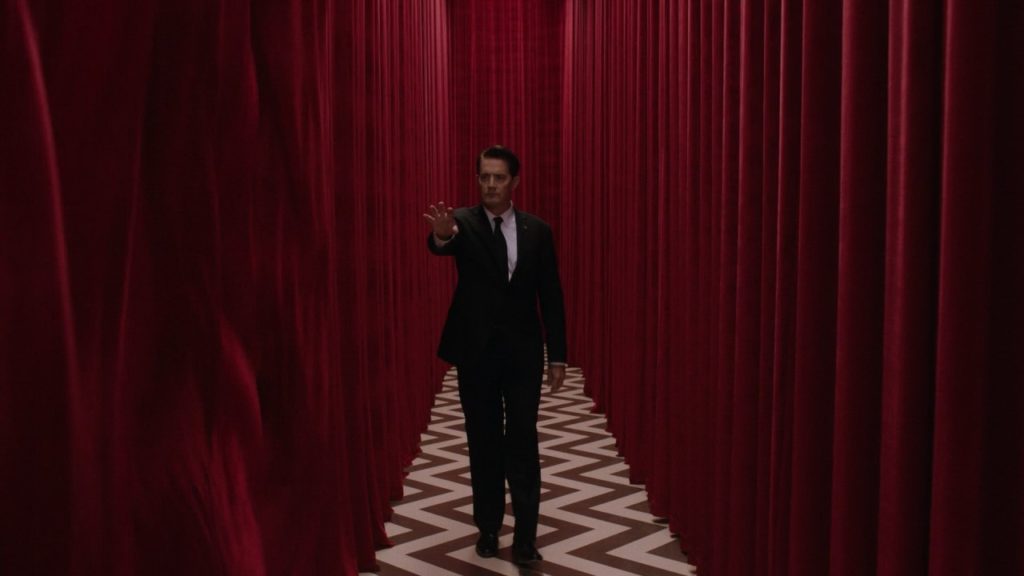
Integrated souls only.
With his doppelganger on the loose, he could not exit the Black Lodge via Glastonbury Grove, only through a bizarre White Lodge bypass mechanism operated by Naido. He bounced off the curtain. In episode 18, he easily opens it with a wave of his hand. With the doppelganger re-integrated into his self (and perhaps with a bit of his Dougie-ness lost), he is now a master of the Black Lodge and the White Lodge. (All references to doppelgangers are absent during his second trip through the Red Rooms.) But with his shadow self comes the heavy weight of guilt and sin that pervades Cooper throughout the final episode. He carries his doppelganger’s crimes with him, so that they too may cruelly serve the greater good.
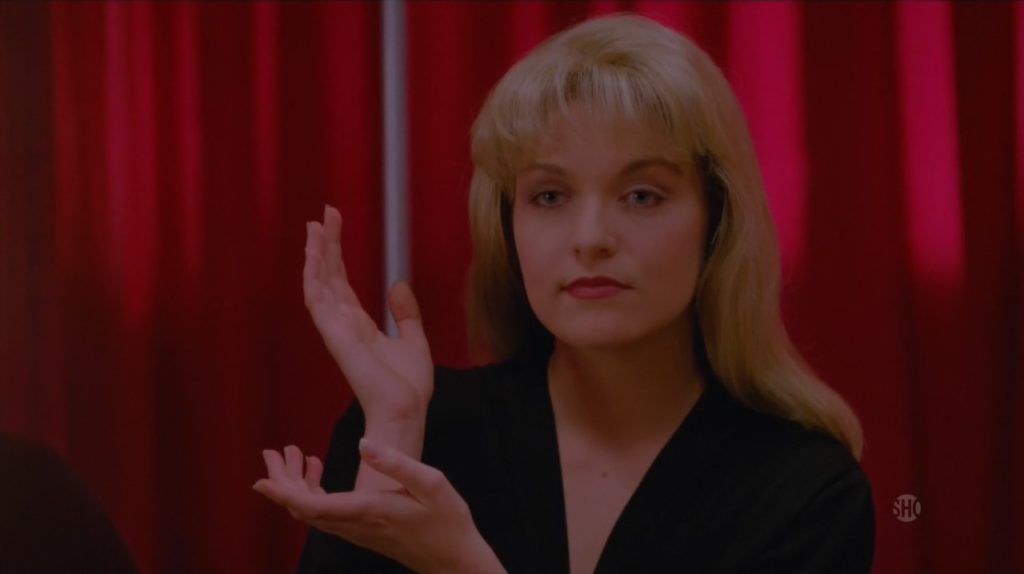
“Meanwhile.”
UPDATE (9/8/2017): I appreciate all the great feedback below. I tried to restrict my thoughts to what I thought were the central puzzles around the ending, but here are a few other stabs at other pieces. I’m less certain on all of these, but I also think that their resolution is less critical to the coherence of The Return. For all its visceral impact, the finale felt incomplete to me in the absence of some greater explanation, and so I was driven to seek one. I hope there will continue to be other attempts to explain the whole story, all its twists and turns.
Audrey: Many have pointed out parallels between Audrey’s situation and the Cage’s dreamworld (which, in Charlie and the Arm’s terminology, would be Audrey and Laura/Carrie’s “stories”). One significant parallel is the retro furnishings: like the first iteration of the motel, Audrey’s house has a rotary phone and nothing I could see that’s more recent than the 1980s, if even then. This suggests she too is in some kind of isolated dreamworld, though probably not the Cage. Perhaps Mr. C stashed her there sometime after Richard grew up (Ben says Richard never had a father, but not that he never had a mother), or perhaps the trauma of raising Black Lodge baby Richard had enough of an effect to send her there. Audrey and Laura both become generic “little girls who live down the lane,” though Audrey struggles against this new story until she finally breaks through.
But when she wakes up, where is she? Lynch’s use of a totally white background is, as far as I know, unprecedented for him, which makes me hesitant to guess, but her clothes do make it look like she is in an institution. The “reality” of the Roadhouse is liminal; it’s the one location that seems to stand in between all the worlds of the show, so the Roadhouse may allow her to transition back to some other world. (The sound of electricity in the background does match up with other instances of cross-world travel.) Maybe she’s awakening from catatonia? I haven’t found enough clues to justify a particular interpretation of her awakening. The uniqueness of the all-white background may indicate that her fate is unknown or open-ended. (Update: Mark Frost’s Final Dossier states that she ended up in a private mental care facility.)
Mr. C: Mr. C asks Jeffries who Judy is, but he does know what Judy is—the entity of evil on the Ace of Spades. He wants Jeffries to tell him who Judy is now, and asks if Judy wants something from him. By this point he is suspicious of Jeffries (who tried to have him killed) and may be playing dumb as well. He may be wondering if Judy wants BOB from him, as BOB is her child, and it’s implied Mr. C would rather not give him up. Or maybe he is trying to return BOB to his mother in exchange for something, and he is inquiring to find out whether Judy is interested. Mr. C’s ultimate plans with Judy remain unclear to me—I suspect it involves the annihilation of the good Cooper so that he can live out his days with his Woodsmen entourage—but he does want to find her. But due to the combined efforts of Jeffries and the Fireman, he is diverted from being delivered to Judy at Sarah Palmer’s house and instead ends up at the sheriff’s station, where the forces of good are arrayed against him and easily defeat him.
Jay Rubenstein raises the intriguing possibility that Mr. C was the one to formulate the original Judy plan with Briggs, which he then took to Gordon after killing Briggs. The timing on this is plausible, though it requires Gordon not to have recognized anything wrong with Mr. C. In this event, the plan was flawed from the start since Mr. C surely had bad intentions, and it took the intervention of the Fireman, Briggs, Diane, and Cooper in order to set the plan aright while Gordon and Jeffries remained in the dark. If so, Mr. C’s phone call in episode 2 could indeed be from Jeffries, but a Jeffries who has finally figured out that Mr. C is not Cooper—hence Mr. C’s surprise and his attempts to ingratiate himself with Gordon while in Yankton prison.
MIKE: MIKE’s motivations were muddled even before The Return. The one constant is that he always opposes BOB, but in Fire Walk WIth Me, MIKE appears far less altruistic, fighting BOB because he wants garmonbozia rather than out of the goodness of his heart. In The Return, he seems far more benign and takes orders from Cooper, but this may also be out of necessity, self-interest, or a desire to preserve the status quo. But why did MIKE give Laura the ring? I think there is an answer that works within the scope of Fire Walk With Me, which is that the ring would take Laura (and her garmonbozia) away from BOB and bring her to the Black Lodge, where MIKE resides. MIKE was not in on any greater plan at that time, and from his perspective BOB was the biggest problem.
Had Laura not taken the ring, she would have been possessed by BOB, and perhaps she would have eventually served as a host for Judy (as Laura is highly fertile with corn, and thus a far better mother candidate than Sarah). Maybe this was the original plan: after Judy possessed Laura, she could be easily recalled to the White Lodge, contained, and detonated somewhere safely. Laura’s death solves the Black Lodge’s BOB problem, but by the time of The Return, Judy is a much bigger problem for everyone—from the perspective of the Black Lodge, she’s a garmonbozia robber baron. This is highly speculative, however, and I’m skeptical of attempts to reconcile Fire Walk With Me too closely with The Return, because MIKE’s apparent character changes so drastically.
Girl (1956): I agree with the common sentiment that if any character we’ve seen is the 1956 girl, it’s Sarah Palmer. The timing matches up, but some other corroborating evidence would be nice. (Update: Mark Frost’s Final Dossier confirms that it’s Sarah Palmer.) But what’s also interesting is why the girl is picked out by Judy’s frogbug. My sense is that she is chosen because of the combination of sexual excitement and shame she is feeling, and the link of those feelings to garmonbozia. The shame stems not only from allowing the boy to kiss her, but also because the boy is not white: both factors which would have caused anxiety in many a fair-skinned 1950s teenage girl.
Red: I have no idea what is up with Red. Sara Tomko and Filippo Malatesti suggest he may be Mrs. Chalfont/Tremond’s magician grandson. Perhaps his question about a singular hand (not hands) is his way of telling Richard to examine his spiritual finger on his left hand? Richard is a horrible human being, but he was doomed to be that way from conception. (Update: in light of the following comments on the diary, I now think the case for his being Tremond’s grandson is quite strong.)
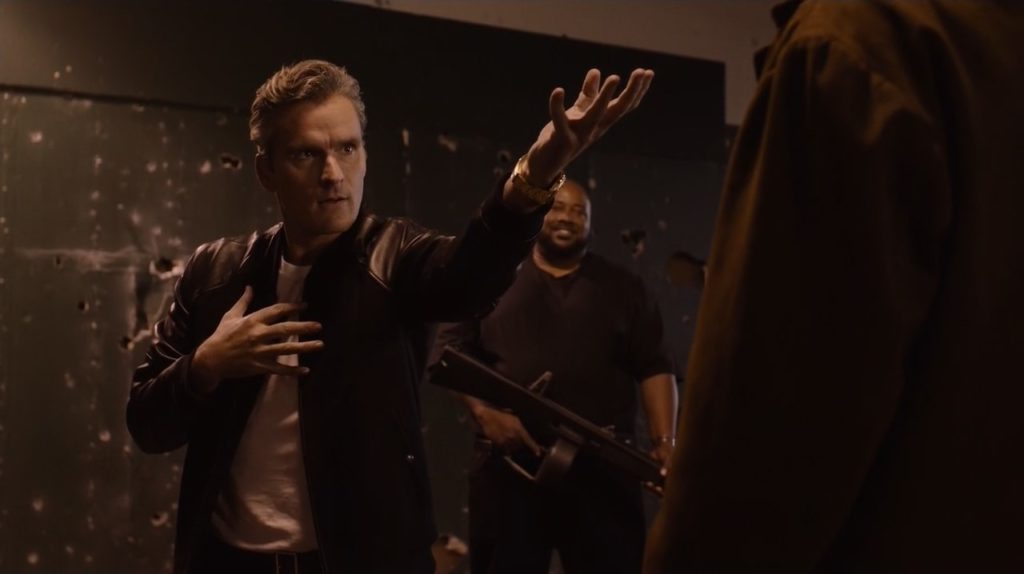
“Have you ever studied your hand?”
Appendix: The Cage and the (Carrie) Page
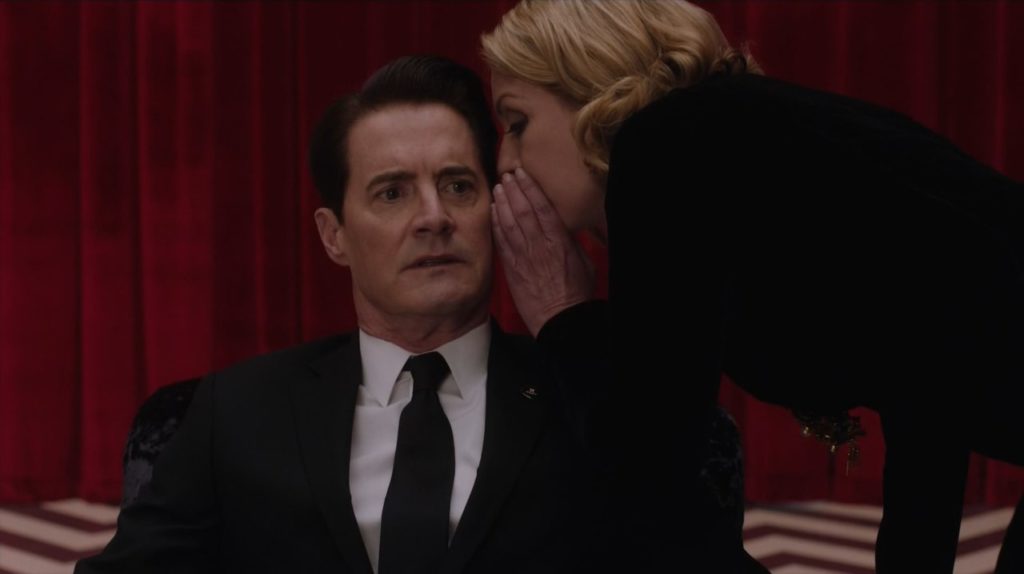
“I leaned over and whispered the secret in his ear.”
After a good deal of reflection, I’m now convinced that Laura Palmer’s diary is considerably more central to The Return than it initially appears. I believe the diary is the Cage.
Consider the following:
- The focus on the missing pages of the diary, by the Log Lady herself no less.
- Hawk’s conspicuous statement that only three out of four missing pages are located, and that Leland surely hid them.
- The diary passed through the hands of Mrs. Tremond and her grandson, both strongly identified with Judy.
- The impossibly tangled chronology of the diary.
- The Tremond/Chalfont connection at the Palmer house in the final scene.
- Carrie Page’s surname.
There is no hint given as to the contents of the missing page. But I think we’ve already been given it. It’s the page Donna got from the “fake” Mrs. Tremond in the original series (ep 2.9):
February 22nd. Last night I had the strangest dream. I was in a red room with a small man dressed in red and an old man sitting in a chair. I tried to talk to him. I wanted to tell him who BOB is because I thought he could help me. But my words came out slow and odd. It was frustrating trying to talk. I got up and walked to the old man. Then I leaned over and whispered the secret in his ear. Somebody has to stop BOB. BOB’s only afraid of one man, he told me once. A man named Mike. I wonder if this was Mike in my dream. Even if it was only a dream, I hope he heard me. No one in the real world would believe me.
February 23. Tonight is the night that I die. I know I have to because it’s the only way to keep Bob away from me. The only way to tear him out from inside. I know he wants me. I can feel his fire. But if I die he can’t hurt me anymore.
This is the last page of the diary. Leland didn’t take it. Harold Smith ripped out this last page and sealed it in an envelope, while mutilating the rest of the diary. How it got into Mrs. Tremond’s mailbox is quite a mystery, since Harold was an agoraphobic shut-in. Mrs. Tremond sent Donna to Harold in the first place, so we can surmise that she played a large part in engineering that entire sequence of events, including Harold’s suicide, and I suspect Harold was in thrall to the Black Lodge to some great extent. As to why the page was passed on to Donna, I’m not certain: perhaps it was a trap for Cooper (in which case it worked).
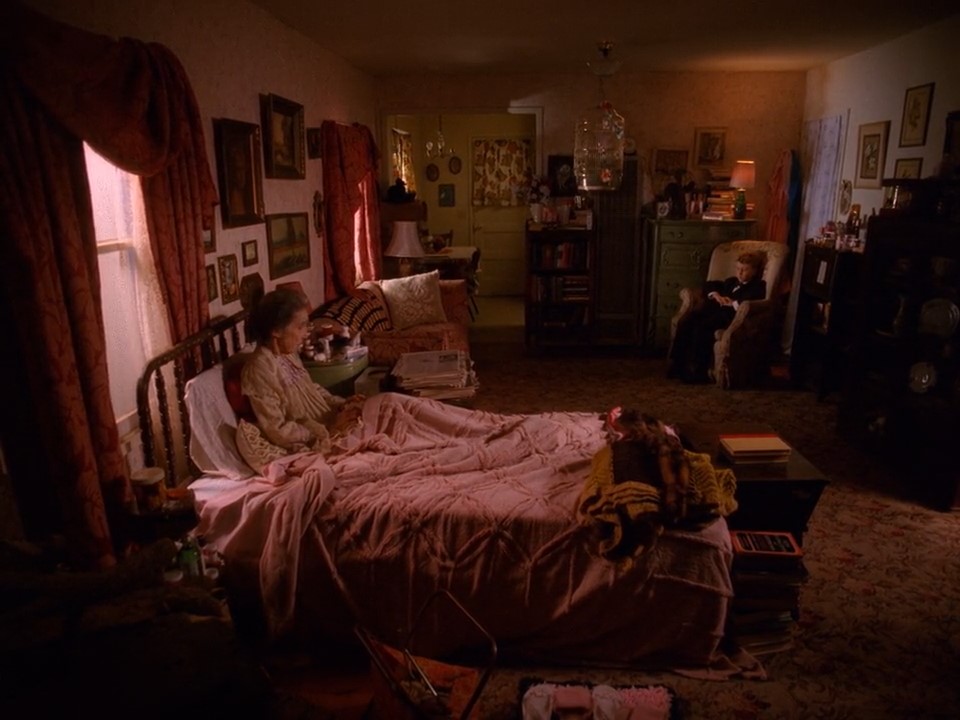
Chateau Tremond
The time sequence in Fire Walk With Me goes something like this:
- Feb 16: Laura finds at least two pages missing (two loud tearing sounds), gives diary to Harold, saying BOB took them. “You made me write it all down. He doesn’t know about you.”
- Feb 17: Tremond/Chalfont gives Laura the red wallpaper painting that acts as gateway to Red Room. (Note: same wallpaper as in Dutchman staircase room in The Return.)
- Feb 17: Tremond/Chalfont’s grandson (dressed as Jumping Man) tells Laura that “man behind the mask” is looking for “the book with the pages torn out.”
- Feb 17: Laura has ring dream with Annie, writes page about Good Cooper being trapped in the Lodge.
- Feb 21: Laura has Red Room dream (ep 2.9)
- Feb 22: Laura writes final page above about Cooper Red Room dream (ep 2.9).
- Feb 23: Laura writes remainder of final page about how she’s going to die (ep 2.9).
- Feb 23: Leland kills Laura, with the torn pages in his possession. (Harold still has remainder of diary.)
Even within Fire Walk With Me, the chronology is so muddled as to be incoherent, requiring Leland to have torn out pages that Laura only wrote after giving the diary away because she found those same pages torn out. Tremond’s statement on its own is paradoxical: the man behind the mask (BOB) is looking for the book which he himself already found and tore the pages out of. I don’t think there is a resolution per se to this confusion. Rather, I just want to use it to point out that the diary is special and temporally abnormal, especially after it falls into the Black Lodge’s hands. This doesn’t mean there are multiple realities. There is only one official reality and only one Laura Palmer. It just means that the diary is closer to the Red Room and the Black Lodge than it is to “reality.”
But it’s that final page (and specifically the February 22 entry) which is most important, since it contains the central scene of Twin Peaks: Laura “Full of Secrets” Palmer whispering a secret to an older Cooper in the Red Room. Not only is it the first and only interaction Cooper and Laura ever properly have prior to the end of The Return, but it also describes the final image of The Return: the credits roll over the shot of the older Laura whispering to the older Cooper.
The Red Room is central enough to the entire show that a diary page describing it is serious business. And it is anachronistic and temporally stretched: is it future or is it past? When Mike asks that question, it’s to say, “Is this dream right now future or is it past?” Even after Cooper changes the past, that dream remains, except that Laura (and the doppelgangers) are no longer in the dream.
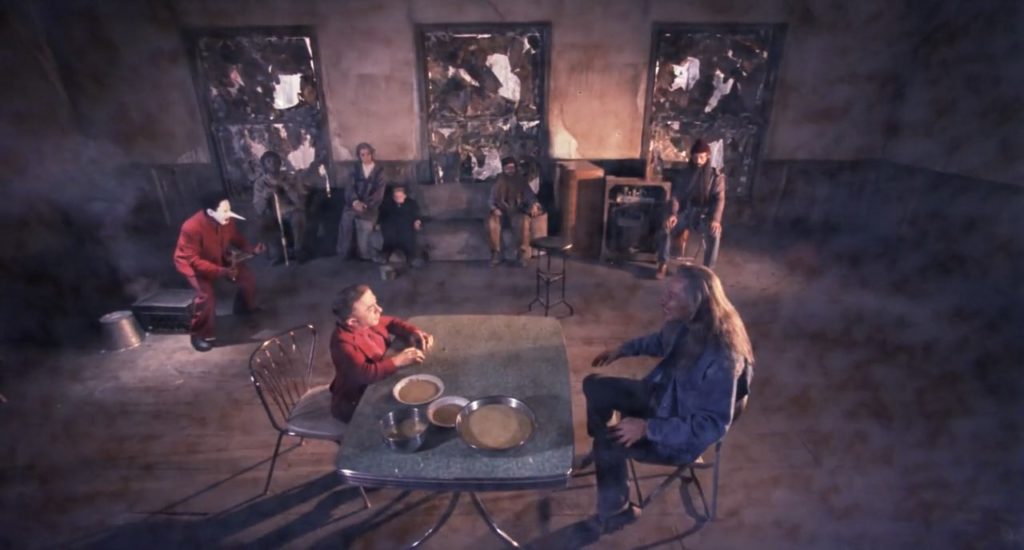
The Whole Sick Black Lodge Crew
(I have been tempted by the theory that the mysterious sound that the Fireman plays for Cooper, and which is heard immediately prior to Laura’s disappearance after Cooper “rescues” her in the past, is the sound of Laura unlocking her diary in Fire Walk With Me. Unfortunately, it’s not the secret diary, which has no lock. It’s her datebook where she stashes cocaine.)
After Cooper changes the past by “rescuing” Laura, the Black Lodge is in possession of the diary. Leland has three of the pages, but Judy could presumably recover these rather easily. That diary, as a chronicle of Laura’s trauma and abuse, is the most significant indicator remaining of Laura’s pain. It’s probably glowing with garmonbozia. Laura, however, is gone.
As for the fourth page, it was never removed, but bear in mind, the dream has changed. Regardless of causality, Laura is no longer in the Red Room dream in the new version, future or past. There’s no way she can write about it at any point in time. Leland says “Find Laura” because Laura is gone from the entire scope of the Red Room experience.
We saw her being removed. Laura’s first appearance in The Return, after she re-enacts the kiss and whisper with Cooper, ends with her being pulled up and somewhat to the right, as she screams. This is followed by a vision of Judy’s white horse, previously seen exclusively by Sarah Palmer. Laura and the white horse are only finally united in Odessa in the final episode. Now, this is my interpretation, but the jagged direction of Laura’s movement is not unlike a page being torn out of a book.
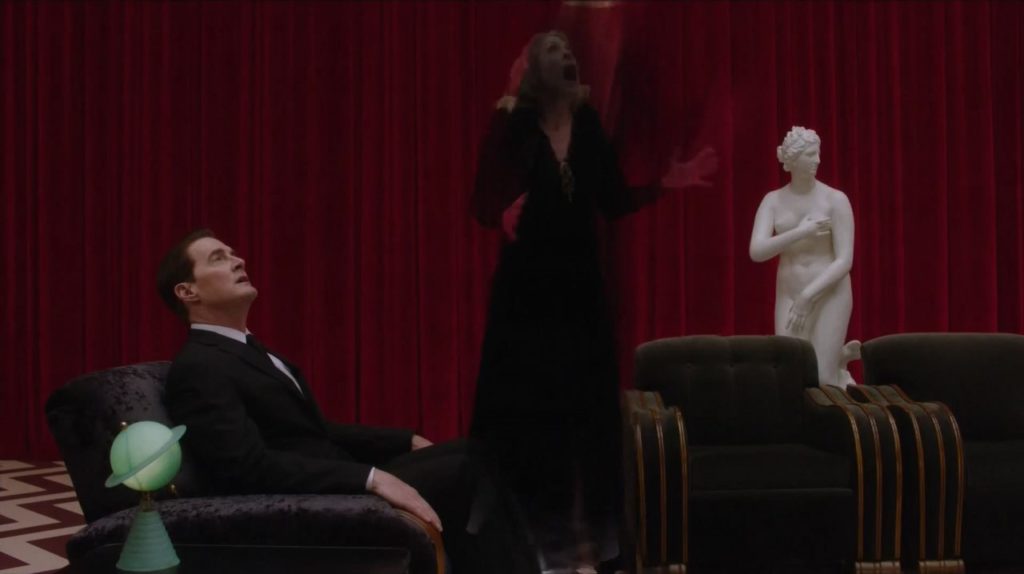
Laura being ripped from the Red Room.
Her scream, again, is identical to the one given when she disappears after being “rescued” by Dale, accompanied by the Fireman’s gramophone sound. So I propose that what Cooper does over the course of The Return, with the assistance of MIKE and the Fireman, is rip Laura Palmer from the story of Twin Peaks, and more specifically from the Red Room. Through unspecified White Lodge machinations, Laura then becomes Carrie Page, the missing “page” of this chronologically screwed-up diary. Disconnected temporally and causally from the conventional world, the diary becomes sufficiently isolated (sufficiently “secret,” if you will) to serve as the Cage. (Perhaps the diary, too, is pulled from “reality” along with Laura.) All that’s left is to lure Judy into it.
The final episode, like the diary, is temporally unmoored. Cooper and Diane serve as the catalyst to summon Judy and detonate the garmonbozia mega-bomb within the pocket world of the diary. As Carrie Page, Laura is the dreamer who lives inside the dream she wrote in her own diary. There were many dreamers over the course of the series, frequently sharing each other’s dreams: Dale Cooper, Phillip Jeffries, Gordon Cole, Audrey Horne, William Hastings, Bradley Mitchum, and others. But ultimately, the dreamer who matters the most is Laura, and her dreams and her diary possess the same nature. Laura is the one.
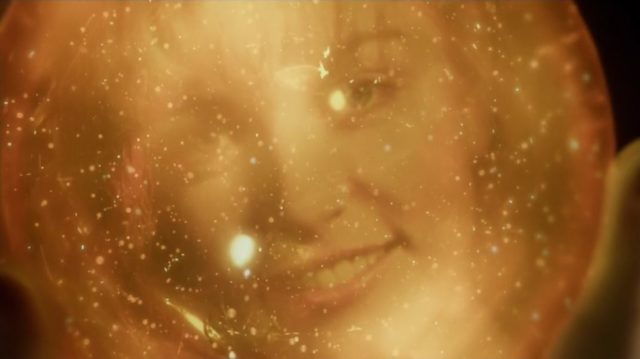
7 September 2017 at 18:06
Amazing you have had the imagination to think this complicated plot to this conclusion. I have enjoyed it immensely. I had no idea this was even a possibility until I read your theory. Will have to go back and see this through another set of eyes. Cheers
7 September 2017 at 19:50
This is one of the best analyses I’ve seen so far for the finale. It’s not the same conclusion I ended up coming to, but I like yours as well. I especially like that you hit on and emphasized the cyclical pattern repetition found throughout The Return.
7 September 2017 at 20:11
A lifetime of reading Gene Wolfe prepared David for this moment.
7 September 2017 at 21:26
I personally disagree with your theory. There’s no indication Judy has been destroyed. ( That’s an incredible leap of faith from the symbolism of lights going out.) There’s also no indication that the people surrounding Cooper and Laura aren’t “real” people. (Cooper doesn’t care about them because he’s starting to act more like Mr. C, not because they aren’t real)
That said it was a very creative interpretation and the show probably defies any definitive interpretation.
7 September 2017 at 22:19
This is very suggestive and perceptive, and I think that seeing Odessa as a cage-reality is excellent and persuasive. However, it just doesn’t seem likely that Carrie is surrounded by symbols of Judy/Black Lodge/evil unless she were put in that environment by them. On the other hand, I don’t understand Cooper taking her to the Palmer household unless that was some part of the plan given to him by the Giant. So I’m still at a loss. I do agree with the previous poster, too, that in this show, good things are usually shown to us as good (with a golden orb, for example), and bad things are shown to us as bad (with creepy music/symbolism). Much as I would like to see a good ending in the finale, I just think that if that’s how it was, it would be a lot more obvious than what certainly seems like a shriek of terror. Of course, this doesn’t mean that it’s not possible, just that I’m not convinced that it’s the most likely explanation. Cool, though!
7 September 2017 at 23:13
This is the most comprehensive response to the conclusion I have read thus far, and so I applaud you. I still have many unanswered questions concerning Audrey, MIKE, etc. but this creative analysis helps shine a light on possibilities I had not thought of myself. I prefer this to the “Judy wins,” theories floating around.
7 September 2017 at 23:23
Agreed – very creative but I just don’t see a positive, victorious read of the ending. Film is an emotional medium above all – yes, even for the surrealist Lynch, he has said as much – and there’s not “good” going on there.
8 September 2017 at 00:49
Very nice analysis, but in my opinion you’re potentially missing some key points. One is that the noise in the White Lodge in the beginning is more likely the sound of Judy, not the sound of the White Lodge. Likewise, it’s probably Judy who plucks Laura up in 1989. My suspicion is that The White Lodge didn’t create the Odessa reality, but knew that it was where Laura would “land”. Similarly, I think Odessa is closer to “our” reality and the end sequence might symbolize Laura waking up, which wouldn’t destroy Judy but outmaneuver her. Lastly, I’ve read a theory that it’s doppelganger Coop who’s in the motel with Diane and I think this theory holds a lot of weight when you really think about it.
8 September 2017 at 01:04
Brilliant interpretation Agent Auerbach! This definitely narrows it down for me.
8 September 2017 at 01:28
I really really liked this theory. Kudos for catching the symmetries in the timeline.
8 September 2017 at 03:10
C[arrie P]age!
8 September 2017 at 03:39
Sheer brilliance! I feel as if you threw me a lifevest just as I was going under! Thank you!
8 September 2017 at 04:10
A very insightful analysis!
Do you have any thoughts on the creature that enters the young girl in the 1950s?
Is it Judy taking hold of Sarah, as many surmised?
8 September 2017 at 04:10
That was just brilliant mate!
8 September 2017 at 04:39
By far the most complete and consistent theory I’ve heard. Very impressive!
8 September 2017 at 05:18
Great work. Fascinating.
8 September 2017 at 06:12
“However, it just doesn’t seem likely that Carrie is surrounded by symbols of Judy/Black Lodge/evil unless she were put in that environment by them.”
But it gets more likely if you think of them as “leading symbols” placed by the White Lodge in order to help Cooper and show him he’s on the right track. After all, how could Cooper find so easily the Odessa-Laura in a reality he doesn’t know well? He certainly needed some clues; matter of fact, after he leaves the motel, he’s driving but he looks hesitant about his destination. When he finally spots the Judy’s Diner, he knows he has to go there to track down Laura.
8 September 2017 at 06:48
This is incredible work. Thank you.
Do you take requests? I’m interested in theories on the original Dougie, the overweight one in the green suit: how did he come about? And how did he end up with Dianne’s half-sister? Did Dianne’s doppelgänger engineer it?
8 September 2017 at 07:13
This is an impressive reconstruction, I’m with you on more than one point, althought I’d disagree on several ones.
In spite of this, I’m still speculating a bit on the question’s side, rather than on the answers’..
I agree that he’s rescuing Laura from the murder’s night, by walking her to the White Lodge (her “original” home), but I’m not sure of what really happens to her.. we hear both the sound the Giants pointed at, in their first conversation (“Agent Cooper, listen to the sound”), followed by a bloody curling scream.
Moreover, and apart from this, I would associate the Black Corn to Mr.C, instead of Laura, since when fire it’s consuming him at the beginning of the 18th episode, it’s spreading out black smoke.. I don’t know if this is philologically correct or coherent with the Twin Peaks universe (I admit.. I’ve really learnt little of it), but iirc that is what Hawks and Truman were talking about.
I beg you pardon again, but you didn’t notice or missed to report that also Mr.C was looking for Judy.
Indeed.. thinking carefully about it, this is what he WANTS, as he told Daryia before killing her. Moreover, for most of the story he’s blindly following or looking for coordinates to a place (or “the place”), but little more.
He wasn’t even headed to the White Lodge, nor to the Sheriff Station (“what place is this?”), so.. were the coordinates a mean to mislead his pursuit?
Are we sure that his story comes to an end in the Black Lodge?
Anyway, the Cooper who walks out of the Black Lodge is clearly another person, even Diane hesitate in recognizing him a second time (or is she tricked again?). Then they actually reach a place near the high tension towers, at 430 miles, full of electricity, which he *senses* to be correct.
What are his intentions at this point?
The sex scene sadly speaks for itself.. and more importantly he looks bewildered when he reads of “Richard and Linda” in the message, like he’s forgot what the Giant said him. The rest of the events really feel like a disgregating dream, with him posing one question after another without any kind of resolution or like he was the ghost of himself. Could be the hartbreak with Diane?
Temporarly, I agree with you again, it’s highly probable we’re in the past.. the furniture, the RR, the car.. speaking of the car, who’s the car following him and Carrie on the road to Twin Peaks?
I don’t have an answer as well for the last minutes.
For the moment I’m just ok with a metalinguistic interpretation, which can be independent from the story’s events flow, with the characters of the show that collapsed into our world, which makes it the most exciting, yet terrifing finale at the same time.
8 September 2017 at 08:31
This is a brilliant theory and I will not be able to see it any other way from now on.
My only hope is that the others we see in Twin Peaks, WA existed and had similar lives. No Coop would certainly change Audrey’s life…
8 September 2017 at 09:08
Problem: DobbleCoop/MrC didn’t know who or what Judy is, hence why he kept asking Jefferies at the Dutchman’s. Yet Mr C is the dark self of Cooper, so should already know all about Judy (via memory inheritance/recall) as according to Cole he, Cooper and Briggs were orchestrating a plan to combat Judy. This suggests Cooper knew/knows all about ‘Judy’ yet his doubleganger doesn’t, despite being able to recall Cooper’s past memories.
My original take on Jefferies flipping out at Copper and refusing to talk about Judy whilst Cooper was there was because Jeffries knew Cooper’s fate and didn’t want his evil double know about Judy.
MrC was looking for Mother/Experiment yet seemed confused about this Judy. This seems to be a big disconnect.
8 September 2017 at 09:22
Also note at the gas station on the way to the Motel, the same car passes twice on the left of the road, not on the right. As a Brit I overlooked this until I remembered drivers in the US drive on the right not the left as the footage was showing….
I also believe the telegraph poles are very important. In my opinion they’re all the same telegraph pole (same seiral numbers, and of course 3 x 6) but in three different realties. One outside Carrie’s house in Odessa (as also shown to Andy), One in the Fat Trout in Deer Meadow (Carl Rod, Chalfonts/Tremmonds, Chet Dresmond dissappearing) and one in or near Twin Peaks (junction of the boy getting run over and Mike and Leland’s confrontation in Fire Walk with Me) Carl Rod again witnessing this nearby. This could also explain their different physical variations.
If this is true we have to consider that at least three different realties/timelines are running in synchronicity, but not necessarily in sequence to the audience.
8 September 2017 at 10:12
Great! I agree with Your explanation but I feel Your theory didn’t put enough attention on Audrey storyline (mostly because of what the Arm told Coop: «Is this the story of the little girl who lived down the lane? Is it?» that is also what Audrey asks of Charlie when he threatens to end her story) and on the fact that the house owners names are Tremond/Chalfont….
Then, for reaching perfection, You should tie this theory with the mysterious things happened in FWWM, like the disappearance/appearance of Chester Desmond and Phillip Jeffreis.
P.S.: what you think about my theory about Red being the older Mrs. Tremond’s Grandson? They both do magic tricks…..
8 September 2017 at 12:33
It’s all very credible. Apart from one thing. If pain and suffering is what keeps ppl alive (so to speak) why was Hastings killed? Apart from Laura and Leland he seemed to me to be one of the most tortured souls in that reality.
8 September 2017 at 12:58
That car in which Cooper and Diane drove through the desert landscape and through the 430 portal looks to me more like 1960 or older, with its bench seats, no seat belts, oversize steering wheel and shift on the steering column. If so, it is possible that they actually drove through a portal and into not Texas but New Mexico or at least within radio range on the very night of the “got a light” event; that we heard the Platters song not twice but once, and that the young girl was entered by that bug thing at the same time as Cooper and Diane were similarly entranced in the motel room (after the camera left them). The next morning, Cooper, now alone, awakens in the present. We next see him entering Odessa but how far did he drive before he got there?
The Chalfont- Tremond team are known by us to be lodge spirits, magicians, shape-shifters, tricksters. They were out to capture Laura earlier, with that painting for example. The woman we saw at the door was Mrs. Chalfont again. I think it’s likely that when Cooper and Laura appeared at the front door, quick action was taken inside that house; that the sound of Sarah’s voice may have been part of their plan, and some sort of confrontation did take place but I am not so sure what the plan was, on either side. The sudden shutdown and then seeming disappearance of the house as Laura began to scream seemed to me to be a Mayday operation, as the house and all its inmates disappeared Tardis-like, or maybe Rocky-horror-like. Laura unbeknownst to herself is not an ordinary mortal but is a being of great power, and is the only person who can confront the lodge spirits and prevail. The confrontation between BOB and Laura in FWWM if I understood it was: Bob wants to possess Laura and her power, but if he cannot possess her than he must kill her. She slips on the ring, he can not possess her, so he kills her. It really is chess, isn’t it? BOB was a major piece, now gone from the board, but the game is not over yet.
Cooper and Laura may be gone for good. Or they may be temporarily or permanently stranded in some alternate reality. Diane may be waiting for Cooper, as Diane, outside the pocket-reality, expecting him to get out eventually. Laura is probably in some basic way un-killable though perhaps immortal only within the lodge. Cooper is a man, a good man, who has had the hubris to become involved with the immortals. A hero-quest indeed!
8 September 2017 at 13:08
I have wondered whether Carl Rodd could be an avatar of the Giant, like the old waiter, dispensing kindness in humble ways. That odd reverie in FWWM when he said that he has been places, and now just wants to stay where he is…
8 September 2017 at 13:19
This. is. FANTASTIC.
There’s only one really major hiccup I can think of, off the top: if Coop doesn’t want Laura to take the ring, and Coop and MIKE are in on the same plan, why does MIKE bring the ring to Laura in FWWM?
Prior to The Return, FWWM establishes the ring as almost solely associated with MIKE. My reading was always that by giving Laura the ring, MIKE was binding her garmonbozia to him (“With this ring I thee wed” says the Arm to BOB”)—such that BOB can no longer accomplish his previously stated desire of inhabiting Laura as he had done with Leland, causing him to murder her instead. (After she puts on the ring, Leland screams, “Don’t make me do this!”)
Then Leland is brought to the Lodge full of blood, and MIKE and the Arm speak as one to BOB: “I want my garmonbozia.” BOB responds by casting the blood to the floor, and we see the Arm eating creamed corn in extreme close-up.
I realize it’s likely (almost certain) that The Return’s mythology was not yet conceived during the making of FWWM, and that it is being retroactively laid over by Lynch and Frost—but I can’t help thinking that this throws a notable wrench into this fascinating, otherwise startlingly consistent interpretation.
8 September 2017 at 13:44
This was a great read. Thank you.
8 September 2017 at 14:04
For a die-hard TP fan trying to make sense out of the Return, this was really useful. Thank you!
8 September 2017 at 14:05
Ya cracked it. You got every little thing that bugged the heck out of me but I wasn’t quite quick enough to piece together. I would like to hear your continuing analysis as you work through it bc I bet there’s more turning around in that rock-tumbler brain of yours.
8 September 2017 at 14:09
So you think Coop and Diane heard the “drink deep and descend” chant over the radio? I like it!
8 September 2017 at 14:23
PRARIE CAGE (Odessa’s known for Jackalope taxidermy, who only mate during lightening storms; who – as rabbits – have occult ties to the worlds above and below, and witches; the myth of which is based on a virus that causes horn-like protrusions that look like black corn; the inverse of which is Adesso, “Now” in Italian.)
8 September 2017 at 14:26
Really good. Never thought to put so much emphasis on the cage. But I hope Judy is dead. Your theory makes sense to me she is now Thank God. The Giant. The White Lodge and it’s players.
8 September 2017 at 14:33
Oh my gods! Is Lynch a Gene Wolfe fan? One of my very favorite authors!
8 September 2017 at 14:37
Let us all now sit and marvel that the creation under discussion is entitled “Twin Peaks”. Like most of Lynch’s oeuvre, it has always been about the dilemma, the nightmare, the predicament, even the opportunity of Duality.
8 September 2017 at 15:04
Having endured 18 episodes of mind numbing tv for it to end with “What year is it?” made me smile the same way the film Birdy ended with “What?” I’m not a David Lynch expert by any stretch of imagination, and the wagging.org explanation above makes my brain ache even more. But just to say, when the Blu Ray box set comes out, I might just buy it and sit in a dark room with huge amounts of coffee to watch the whole 18 hours again in one go and let it sweep over me for what it is – crazy creative tv popcorn made by Agent Cole’s alter ego. That’s all folks
8 September 2017 at 15:53
yeah. Twin peaks ended at season 2.
The return was crap and should be erased from history
8 September 2017 at 16:00
Thank you, this is a fantastic and thought-provoking summation and analysis. Really excellent work, and beautifully illustrated.
Personally, I think the story could and should continue, because, to quote The Elephant Man, “nothing ever dies.” Whether or not Cooper has been traveling in, or must now begin, his soul’s journey through the Tibetan “Bardo” state (as some have theorized), I deeply hope that this iconic character’s next challenge, mystery, and/or life are still waiting for him, and that he is not obliterated or caught in an existential hell with no exit.
To me, the golden Laura-orb seems to contain something more like honeyed “Ambrosia.” Perhaps Garmonbozia and Ambrosia are the two distinct material states of this “thought-energy,” depending on the intention behind it. They are expressed most purely by humans as “Fear” and “Love,” the latter being the source of The Fireman’s power- but there remains, as always, the possibility of both in the finale.
In horror, the last shot of Cooper back in the Lodge suggests that he may be caught in an endless Möbius strip, living and reliving these events for all eternity. However, a more hopeful theory stems from what you suggest, that Cooper and Laura’s sacrifice has successfully short-circuited the negative feedback loop of this all-encompassing victim-perpetrator double-bind between Judy and Laura. With this challenge met, perhaps he can now “move on,” or, when “the stars turn and time presents itself,” again return to our world, at least in some form.
Season 4 in 2020!
8 September 2017 at 16:37
Might the young girl who swallows the frog/bug have been Sarah Palmer, perhaps in Odessa, TX?
8 September 2017 at 16:48
Very interesting analysis. I think you have some good insights even if I don’t agree with all of them. I disagree that the white lodge created the alternate reality for a couple of reasons. One was that Cooper had to go to Jeffries to find out where Judy and Laura were. If the Fireman had created it, he wouldn’t need to go to Jeffries. The other is the scream when Laura was ripped away from Cooper in the forest and the black lodge. My interpretation was that both of those moments are linked and are Judy pulling Laura away to hide her in the alternate reality. All of the scenes of people and tulpas being pulled to the black lodge have been violent, whereas people going to the white lodge simply disappear quietly. I think Judy intended for Laura to forget who she was so she would be less of a threat. It was a risk for Cooper and Diane to cross over to the alternate reality, which seems to me an indication of it being created by Judy. In FWWM, the intent was not to get garmonbozia from Laura, it was for Bob to possess her. Laura chose to be killed rather than possessed. So I’m not clear on what the goal was in bringing Laura to the house. I don’t think it was some kind of garmonbozia bomb. My impression was that Cooper was losing himself and Judy snatched Laura away again once she started to remember.
8 September 2017 at 17:38
“Gordon Cole, Garland Briggs, and Cooper have had some kind of longstanding plan to deal with Judy, in partnership with Phillip Jeffries and MIKE”
I don’t see how Jeffries and especially Gerard are Judy’s adversaries. MIKE is carrier of her Ring and butler of her Lodge; Jeffries is her prisoner. On the stairs we see Jumping Man/Sarah. The leads to Judy are obscure; Cooper follows Laura and saves her (much as he can). She’s ripped up by Judy. Laura to Cooper: “You mustn’t have interfered, it is happening again.” Leland, sorrowful: “Find Laura.” Cooper meets Diane. Diane is another Black Lodge agent (the hair, the nails), maybe the same “tulpa” reincarnate, sent to contain Cooper but failing due to her emotional entanglement with him again. She disassociates to the extend of becoming “Linda”. Cooper/Richard is unstoppable in finding Laura, yet his quest for Judy leads them to Laura’s house. He has forgotten all about “home” (the White Lodge).
It is strange that Dale is asking Jeffries for the date before Laura died, and the latter tells him: “Here is where you find Judy”; then cutting to Laura’s house.
Sarah’s torment (in the present) might have been caused by the realisation Laura is no longer with her. A karmic bond has brought Cooper to Laura, and Laura back to Sarah/Judy… and the story begins anew in 1989, for Cooper at least. Perhaps without Laura who’d never make it back Home.
8 September 2017 at 18:01
Not that I’m 100% convinced of this theory but this ending would only be happy for the real world. In this dream world theory it was a bleak ending despite saving the world because Diane was overcome with her grief, Cooper resurrected Laura to rub her nose in her terrible past and everyone inside that dream world provably collapsed with it.
Again, I like this theory but I’m not saying I’m convinced all the way either, however happy music wouldn’t fit an ending where half the main characters die and leave behind an altered timeline that is only hopefully less evil.
8 September 2017 at 18:05
This theory isn’t a full out happy ending though. The ominous tone fits this theory because they are removing a great evil force from the world but sacrificing themselves in the process and Diane was so overcome with grief she won’t even be there for it. I think this folly justifies the dark tone still, although I don’t necessarily believe there is one single explanation I do like this idea.
8 September 2017 at 18:45
What if the “explosion” is triggered by the shock that a lifetime of PTSD all brought back in an instant would deliver?
8 September 2017 at 19:46
Hastings had to be killed because he knew too much. Diane arranges for his assassination by the Woodsman after telling Mr. C that he was leading Gordon and Albert to the site.
8 September 2017 at 19:47
Does that figure-8 embroidered wall covering in Richard’s hotel room (on the wall next to the bed when he wakes up alone) have any bearing on this theory? I’m sure someone has mentioned that, but I haven’t seen it discussed yet. Great theory by the way.
8 September 2017 at 19:47
I love this theory, much moreso than Steven is Mrs. Tremond’s grandson. “Magic motherfucker!”
8 September 2017 at 19:49
Adding to the point of Gordon being Machivillian, I feel that his “hearing problems” might be a form of PTSD from the weight of guilt sacrificing others and fighting extremely dark forces. When there is Sharp, loud noises Gordon experiences pain. Also, he feels these symptoms greater around dark forces e.g. Around Dark Cooper in the prison visit and Diane’s doppleganger when his agents have to shoot her and he is rendered powerless. He is comparmentilizing through his device and through managing difficult experiences.
8 September 2017 at 20:55
My take is that DobbleCoop/MrC knows *what* Judy is (even Hawk knew something about the symbol), but doesn’t know exactly *who* Judy is currently being hosted by or where he can find her. And that Dale never really knew until after the DobbleCoop split in the finale of Season 2. Whatever plan Dale, Jeffries, Briggs and Gordon had planned has already started to fall apart, or has already unraveled, by the time Season 3 starts.
8 September 2017 at 21:24
This is excellent. I also just read a theory about parts 17 and 18 being meant to be watched in sync with each other. That theory very closely matches a lot of what you have here but I like your theory better. There are some unmistakable things that line up though when the two parts are viewed in sync. May be worth a read to see if if fits your theory?
8 September 2017 at 22:36
The Return seen as a palindrome is a great one, especially with recurring ones already such as BOB and MOM. “Phillip” is so close to being another.
8 September 2017 at 22:54
MOM BOB MOM!
9 September 2017 at 00:09
Well, the story’s over, so usually that means the bad guy has been defeated.
9 September 2017 at 00:45
Red seems to be a dark magician! Aka Mrs Tremond’s grandson 25 years later still hanging around the RR aka the meals on wheels location with Shelly, whom he met in the parking lot 25 years earlier when he and his grandmother brought the photo of the door to Laura. Just a thought! I agree with this whole article!!! Wonderful!
9 September 2017 at 00:55
Personally, I interpreted Red to be another Black Lodge spirit or evil doppelganger set free in the world, very similar to Mr. C. Unlike Mr. C, Red’s story happens to be very tangential to the events of The Return, but like Mr. C, he’s engaged in all kinds of shady enterprises, of which we only catch some brief glimpses.
9 September 2017 at 00:59
“The daughter’s trauma, caused by her father, destroys her mother.” is literally the point of the very first Twin Peaks episode. :D
9 September 2017 at 01:01
Couldn’t the black fire also be Mr. C because we see him like that after being defeated?
9 September 2017 at 02:16
Why would it be doppleganger coop in the hotel with Diane when the doppleganger was Mr C who was defeated? Coop was split into two upon first entering the black lodge. Mr C was his shadow self while Dougie was his good side. When he goes back through he merged into one, sort of this complete coop..Once they cross the 43o mark I tend to agree with the article above but it’s ambiguous, which is disappointing.
9 September 2017 at 04:46
Hi all! Really great theory! I dont’ know about one thing still. What was that radio what shrinked into a small tiny radio at one the first episodes? Mr. C phoned to it and it shrinked somewhere.:D Audrey was in an asylum in real world i think, but she had visions may be because of her trauma of her life or because of the drugs she got.
9 September 2017 at 08:23
This might be what Frost had in mind, but tbh it is totally irrelevant. As u said Lynch improvised all over it. This is Lynch’s show, and for Lynch (as is always the case) coherent macrostructures and diegeses are besides the point, and the force of his work resides in the inextricability of cognition and causality from sensuous particularity, as a corrective (in semblance) of the rationality alienated from particularity which predominates extra-aesthetically. The whole exist solely for the parts, so if you’re busy trying to work out how the parts exist for the whole you’re busy destroying the truth-value of his work.
9 September 2017 at 10:43
Smart and fun analysis! You made my day and helped me to hold on to feeling immersed in the show for another week.
9 September 2017 at 13:35
I was going to say the same thing about the car. I kind of wanted to ask the age of the writer, but didn’t want to age myself, but that is NOT what cars looked like in the 80s. It resembled my mom’s old 67 Chevelle. I’m sure that’s not what it was. It just reminded me of it.
9 September 2017 at 15:03
Great comment. Gene is the master.
9 September 2017 at 15:31
This entire theory is predicated on a supposition for which there is literally zero evidence, whatsoever, of: the idea that destroying Judy is, for reasons that are totally unexplained, an apocalyptic event. This isn’t just a minor detail in the overall theory, this is the entire foundation for why the alternative universe in episode 18 exists and it’s pure conjecture that, if true, means that Lynch and Frost are both deeply incompetent story tellers. Fun theory I guess, but completely groundless.
9 September 2017 at 16:14
I’m not sure how much more apocalyptic you can get than an entity who is equated with the atomic bomb.
9 September 2017 at 16:10
Thank You for this awesome, detailed analysis of your very exciting theory! And also thanks for sharing that Reddit-thread, I´ve been trying to figure out this stuff too much on my own and frying my brains in the process :)
After watching S3 finale twice I came to the conclusion that Judy is indeed in Sarah Palmer and that two birds with one stone meant both saving Laura and destroying Judy somehow in other timeline/parallel universe but that it failed in the end for Coop and Diane that made the trip when everyone else was “saved” in that reality they left behind (where Laura lived).
This made me pretty sad camper and reading this excellent theory and buying into it makes the end much nicer, they finally pulled it off as the electricity peaked and cage blew up although they had to Laura with them too. I dind´t realize Laura as a weapon but as an entity that just needed to be saved, goodness was left to the world and so on, and I pretty much got that reset of Coop´s and Diane´s relationship all wrong.
Started to watch the series from the beginning by the way immediately after finale viewings and I can recommended it highly to everyone. Very interesting to watch dynamics of Palmer´s and especially Sarah – her consciousness seems to be shifting from that catatonia (which was all I remembered) to being perfectly clear (and malevolent) and she´s going on and off from the possession or Judy-mode in many scenes like when raging for the first time to grieving Leland.
9 September 2017 at 17:14
See, I saw it slightly differently. I thought Carrie’s resemblance to Laura was completely coincidental, and that she was dangerous to Judy simply because she was a member of my extended family, and therefore deeply dysfunctional in a way that even the Black Lodge had yet to contemplate.
9 September 2017 at 19:30
And what about Hawk?
He knows important things and the messages he gets from Margaret seems to imply that he will be an actor in the upcoming events. But nothing at all happens with him.
9 September 2017 at 19:43
What about the similarities between Carrie and Audrey? Carrie is looking for someone (asks Cooper if he’s found him) just like Audrey is looking for Billy.
Audrey is waiting for the phone to ring, Carrie’s phone is ringing off the hook. (We saw earlier that Mr. C exited the convenience store using a phone).
Carrie doesn’t know where Washington or Twin Peaks are, Audrey doesn’t know where the Roadhouse is. Audrey doesn’t know who she is just like Carrie has forgotten she’s Laura Palmer. Audrey chokes Charlie on the couch, There’s a dead man on Carrie’s couch. Audrey puts on her coat ready to leave, just like Carrie does.
9 September 2017 at 20:05
Good observations. I’ve always had the feeling that the Audrey vignettes are crucial – mostly because they seem so disconnected from the rest of the story!
9 September 2017 at 20:24
My only thought about Red is he might be connected the Tremond’s grandson (who’s connected to the Jumping Man) — he does ‘magic’ like him (remember when he made garmonbozia go from the grandmother’s plate to his hands in that scene with Donna in the original show?)
I don’t think Cooper is as altruistic as you are claiming. At the heart of it I feel like it’s Cooper wanting to erase his and Mr. C’s past mistakes. If Laura never died he never would’ve went to Twin Peaks and met Bob and got trapped in the Lodge. Sure Cooper wants to erase all the hurt he and his doppelganger have caused others, but it’s also his way to trying to cope by making it like it didn’t happen because he doesn’t know how to deal with the enormity of the crimes. His attempt at facing what he did to Diane (trying to remember during the sex scene what happened, but he’s basically trying to go into the memory of when he was Mr. C so there’s a disconnect) seemed to have failed, so he’s trying to go back and erase all of it like it didn’t happen, not just to release her burden but his as well.
Also it’s interesting Cooper couldn’t ‘wake’ up until Mr C killed his son, like that was a living reminder of what he had done.
The Little Girl Who Lives Down the Lane… maybe the arm was trying to say Cooper needs to make it ‘right’ with Audrey, but Cooper thought he meant Laura, or took it to mean Laura because that’s how he wanted to see it. If Laura never died he wouldn’t have to deal with all those uncomfortable emotions of everything that transpired and everything would be okay.
I also question how ‘real’ Diane actually was in these last two episodes. Her bright red hair and black and white nails looked just like the lodge.
9 September 2017 at 20:40
Wouldn’t the 1956 girl be consistent with Sarah Palmers age? Plus, the bug (antenna) consistent with Judy? Taking human form maybe? While he men were chanting about a white horse (white of the eye with BLACK inside)
9 September 2017 at 20:43
All of this and Gordon’s office art of the bomb and of Kafka! Metamorphosis! Bug! It’s all connected! Gordon knows everything! … well he did write and direct most of it
9 September 2017 at 20:44
Congratulations on a stellar entry. :D Easily my favorite working theory thus far and one I’ll take with me to the Final Dossier. By the way, on Judy being drawn to sex–Are you familiar with the work of ufologist John A. Keel, author of The Mothman Prophecies? More than once, he expounded upon the number of reasons ‘Big Hairy Monsters’ like Sasquatch accost young lovers. My feeling is that Mark Frost in particular was influenced by Keel in building Twin Peaks while Lynch approached it through meditation. Thanks so much for sharing. :)
10 September 2017 at 00:06
To be clear, you are saying they made Laura suffer so much because eventually she’d release so much garmonbozia it would overload Judy?
10 September 2017 at 02:54
Well this is probably about as good an explanation as I’ve seen and that we’ll get, barring Lynch/Frost spelling it all out. I like how it juxtaposes with the theory flying around about the 2 Roadhouses (as evidenced by the differences in seeing the neon sign normally, and seeing it reflected in water). If that’s the case then the water-reflection version of the Roadhouse could exist in the Cage as part of Laura/Carrie’s repressed memories. It contains all the melodrama from the previous seasons that would have been part of Laura’s memories of it. Audrey being a part of it could be her getting sucked into it from wherever she is (some mental ward presumably) or possibly dreaming about it. And the moment when Laura screams, shattering the world is the moment she ‘wakes up’. This would presuppose that she’s somehow able to view the Cage or, as she alluded to in her Twitter post ‘be the dreamer’ (she posted a pic of herself with the caption ‘Who is the dreamer?’).
This is a very unformed thought. It presupposes that Sherilyn Fenn is somewhat privy to deeper details of the script and plot, and we know that Lynch and Frost kept that from most everyone except for Kyle.
Anyway, Kyle did say before the season aired that ‘everything would be resolved’ (paraphrasing) by the end, so this probably means if there is a season 4, it would be something totally different. I think as it is, it ended perfectly, if horribly. I got that same feeling as I did seeing the end of season 2… total dumbfounded bewilderment, yelling at the screen ‘IS THAT IT??’. Well played Lynch and Frost, well played.
10 September 2017 at 03:33
I believe Hawk to be a White Lodge ‘deep undercover agent’. He knows much but says little. He is at the very least associated with a tribal understanding of the Lodges. He knew that one shouldn’t speak of the little devil symbol as Judy, presumably so it wouldn’t attract any undue attention. He saw the red curtains at Glastonbury Grove. His relationship to Margaret is interesting. If you read the Secret History of Twin Peaks you get much more information on her that is significant. She herself is likely a White Lodge agent, what with her abduction and emergence with the same symbol that Briggs showed up with (one that Karl from the Fat Trout also bears). It wouldn’t surprise me if Andy had one too, as he was drawn into the Lodge and given information that ultimately helped the plan along.
10 September 2017 at 07:17
If that’s the case wouldn’t Judy actually be Laura’s mother?
10 September 2017 at 10:59
Why Mr. C put the Owl Ring on the Ray’s body finger? Thats how ring returned in to the Black Lodge. He could save it for himself and he could save his own life by that. Because they eventually killed Mr. C and transfer him back to the Lodge with exactly that ring.
10 September 2017 at 11:14
Ditto!
10 September 2017 at 16:31
One thought re: Mr. C is that he wants to enter “The Cage” and kill Carrie before the plan can be executed. This assumes a sort of four-dimensionalism about the time travel loop but that doesn’t seem out of bounds. I wonder if (on your picture) rather than thinking of Audrey’s circumstances as parallel to Laura’s it makes more sense to think of them as parallel to Diane’s. Cooper had romantic feelings for both of them and it could be the case that the sex ritual requires such feelings to exist (which is why the experiment just killed the casual sex couple in the first episode). When Mr. C assaulted both women it could be that was trying to exploit these feelings to perform the ritual himself (but failed because he isn’t capable of such feelings nor even of minimal empathy), or that he was trying to close off the possibility of Cooper performing the ritual with them. Diane was somewhere before she emerged from Naido. I still tend to think she’s coming from the timeline where Laura wasn’t killed and so Cooper didn’t leave for Twin Peaks and instead had a love affair with Diane. I think this because Diane’s tulpa explicitly tells us she had only kissed Cooper once before Mr. C assaulted her, and the dynamic between Cooper and Diane after she emerges from Naido strongly signals that they have a sexual relationship. That interpretation isn’t compatible with elements of your story, but as an alternative, it’s possible that Diane was trapped in a limbo like Audrey is before being extracted by the Fireman and informed of the plan.
11 September 2017 at 00:25
Good points. I still am uncertain about Mr. C’s exact motives. He says that he “wants” Judy. What does it mean to want Judy? Her power? Her maternal protection? Something else?
10 September 2017 at 18:05
Diane is Audrey’s tulpa. Audrey is trapped in the Twin Peaks Sheriff’s station, where she overhears from the others the details she tells Charlie. Audrey is the dreamer, and it’s possible that most of the season is her PTSD dream world attempting to cope with her rape by Cooper.
Clues: Last episode confirmed that Diane (or her tulpa) was raped by Mr. C. Richard Horne is confirmed as the child of Audrey Horne and Mr. C. Many have theorized that DoppleCoop raped Audrey to conceive Richard. It could be that Diane is actually describing Mr. C’s rape of Audrey.
Diane, before disappearing, says “I’m not me” and “I’m in the Sheriff’s station”. Audrey says several times in her “hallucination” with Charlie that she feels like she’s somewhere else “and like I’m somebody else”.
The details Audrey tells Charlie are details about other people in the jail of the Sheriff’s station. Ie, she says she had a dream about seeing Billy “and he was bleeding from the nose and mouth”. The drunk in the sheriff’s station is bleeding from the nose and mouth. Audrey’s dance sequence at the Roadhouse is interrupted by a man screaming “that’s my wife”, which is what started the fight between James, Chuck (“certifiable”) and the guy with the magic glove in the previous episode. James and his superstrong friend then get locked up.
Audrey always fantasized about helping Cooper crack the Laura Palmer case, and witnessed him recording messages to Diane.
Diane wears the same kind of red heels that Audrey changes into in S1E1 when she gets to school.
Diane and Audrey both smoke cigarettes.
Theory:
Tulpas don’t have to resemble their creators, they can look like anyone, ie, whatever the dreamer imagines. It’s possible that Audrey is “trapped” in the sheriff’s station like Josie was trapped in the wooden knob of the Great Northern. Unable to escape, she wishes for Cooper to rescue her, and dreams up Diane the tulpa to help find Cooper.
But I think there’s another layer at work here. Like in FWWM, where Lynch walks back some of the black lodge mythology in a way that makes it seem like Laura’s fantastical escape from the horror that her father raped her. As Cooper says, “is it easier to believe that a man raped and murdered his own daughter?”
A la Lost Highway / Mulholland Dr (the latter of which was supposed to be an Audrey spinoff), much of the season – the “two Coopers” – is merely a psychological breakdown / dream state Audrey has created to reconcile her rape at the hands of someone she cared for. In her fantasy, the “good” Cooper that she pined over in the original series must come back to defeat the “evil” Cooper who raped her. In this world, Cooper’s good and bad sides literally become personified in Dougie/Cooper and Mr. C. In this fantasy, Mr. C destroys Richard, symbolically “undoing” the evil offspring of the rape. But the reveal is that there has only been one Cooper this entire time – hence why the timelines do not line up and suggest that Mr. C’s journey happens before Dougie/Cooper’s. Audrey, trapped in the black lodge or something like it, uses the black lodge entities to urge Cooper’s good side to “wake up”. He then sets off for the Sheriff’s station to find Audrey and make amends for his crime.
10 September 2017 at 18:06
I like this theory very much but I think it must be mixed with a (long) dream of the real Cooper in the Black lodge (and therefore it’s even more complicated).
Indeed, the “real” Cooper has no FBI Pin when he enters the Sherif Station (Part 17) and just after the “Bob killing scene”, when he walks with Diane and Cole to enter the room with the “315 key”, he has the FBI pin (and then till the end of Part 18). Moreover, this room most surely can’t be opened with this key in the real world (it’s not his ancient room when he was at the Hotel in 1989).
Can somebody help me to understand ?!
Many thanks,
Ph
10 September 2017 at 18:16
One of the things I’ve noticed about Season 3 is how scatterbrained and disorganized it was, with quite a lot of cameo appearances. Don’t get me wrong, there was a lot of goodness in there, but the plot was pretty messy and not in the normal Lynch ‘it’s a puzzle’ way.
I got the feeling that there once was a very coherent and tight story, but as Lynch said yes to so many of his friends for roles in the show, the adaptations became more and more unwiedy. We wound up with plot lines that didn’t seem to connect to the world. Frank’s wife and suicidal son, Wally Brando, armpit burger flipper, the drooling guy in the jail, etc etc.
So the most glaring aspect of this is Audrey Horne, but her footprints are all over the show anyway. The coma mention, her son being Dale Cooper’s son (and then murdered in an apparent theme of parents betraying children), and other things.
I believe that the story arc Diane portrayed actually came out for her to replace the Audrey arc in order for an actress with better skills, more star power, and a better relationship with Lynch, to get a leading role that was actually intended for the character of Audrey Horne. Just think how much more satisfying the show would have been had Diane remained the classic unseen character (perhaps even forgotten) and Audrey’s reveal was in that early episode, in that bar, saying Fuck You to the FBI, her hatred representing her abandoned dream of being an FBI agent and her rape by Evil Dale which produced her son Richard. She’s then deputized, realizing a long held dream. We later learn she’s a doppleganger of Audrey and get the real deal Audrey around the same time Dale snaps out of it. Their love is finally requited for real, they have those long driving scenes in the finale, only these satisfy an arc from almost 30 years ago.
Probably Dale’s murder of Audrey and Dale’s son would have had far more significance and impact. Far far less justifiable is a sense that maybe Janey E was going to be played by Sheryl Lee (with zero memory of Laura), and her recovery in front of her real house was brought on by Dale… making it a lot more feasible that she would travel with him across the country. I feel like the Carrie Paige character is extremely poorly thought out, not even knowing where Washington State is, having a forced accent.
I think Laura Dern and Naomi Watts are awesome actresses, but I also think they were given enormous roles over the actual Twin Peaks story lines of Laura Palmer and Audrey Horne, which didn’t move that much… maybe three minutes worth. Had they instead lived out most of the season I think this season and this finale would have an entirely different feel.
While the Laura one is just a stab in the dark, I strongly believe the Audrey one is accurate and reflects a lot of the buzz about Audrey finally getting to complete the arc leading to Dale that was screwed up in Season 2, and really the whole role Diane wound up playing.
10 September 2017 at 22:26
I agree with you on quite a bit of your theory, but there is an important point that I believe is wrong because you’ve based it on an incorrect observation.
The sound we hear when Laura is ripped away from Cooper and also when Cooper and Carrie visit the Palmer house is not representative of the White Lodge, it is representative of Judy.
In the first episode, first scene and first few lines of the series spoken by The Giant/Fireman, he makes it a point to let Cooper know what Judy sounds like, (not the lodge) by saying the following:
“Agent Cooper. Listen to the sounds.”
From the gramophone comes the eerie ratcheting sounds over and over again.
“It is in our house now.”
The Giant/Fireman, in an attempt to show Cooper that Judy is in fact “in their house now” is playing him the sound that identifies her, Judy. Not the White Lodge. This is straightforward, IMO, based on the context of the conversation and dialogue in which the sounds are introduced. The Giant/Fireman is identifying Judy for Cooper.
This means Judy was the entity that ripped Laura away from Cooper after he saved her and also was the entity that most likely created and placed her in the alternate dimension. It is still possible that the White Lodge knew this would happen after Cooper saved her though, and thus had prepared for it by letting Cooper know about 430.
11 September 2017 at 02:58
Thank you to have created this blog and developed your theory about season 3.
Thank you to all the other Twin Peak fans to react and give their ideas.
I would like to give a feeling I had concerning the death of Billy, the Mr. C and Audrey’s son.
(1) Phillip Jeffries wants Mr. C to be killed. I think that Ray received his order to kill Mr. C from Jeffries. Ray failed because Mr. C was saved by Woodmen.
(2) Phillip Jeffries gave some coordinates to Mr. C when they met in the gas station. For me, Jeffries prepared a new trap to kill Mr. C. The coordinates he gave to Mr. C are the coordinates of the trap.
(3) Mr. C suspects Jeffries to be the guy who wants to kill him but he is not completely sure of his betrayal. He looks for Judy and the coordinates that Jeffries gave him could be the good ones. He goes to the place corresponding to these coordinates with Billy to be sure that Jeffries wants to kill him.
(4) Because, he is not completely confident in Jeffries and anticipates a trap, he asks Billy to go to the location indicated by Jeffries. Mr. C does not want to kill Billy but he sacrificed him to verify if this is a trap or not. The death of Billy confirms the trap. The death of Billy does not touched Mr. C because Billy is just an instrument for him to reach his goal.
11 September 2017 at 04:29
Great analysis – a few points.
Do you agree that chronologically (at least outwith the Lodge worlds) the show ends with the clock in the sheriffs station hitting 2.53 and reality resetting itself? The return of Diane and the superimposed Cooper suggesting they have returned from their mission. Wouldn’t this invalidate your theory that Cooper and Diane were on a suicide mission?
Is it possible that throughout the entire series we’ve been watching disconnected scenes from different realities/timelines? Perhaps the timeline we’re used to as well as an alternate ‘Laura was never murdered’ stream? This would explain the shifting backdrop in the RR Diner, and some of the more outlandish incidents that were never addressed (the exorcist kid, the hit and run, Reds magic – also odd Roadhouse happenings such as The Nine Inch Nails and James Hurley headline the Roadhouse). I feel there’s much to uncover here and the apparently random nature of the storytelling might reveal a deeper purpose. Did the altered realty lead to the good stuff like Nadine, Norma and Ed or the bad stuff like the drug outbreak and the kids death?
Finally, where does this leave The Final Dossier? Which timestream will it be addressing? Will be fascinating to see if we’re tracking a world which no longer exists/never actually happened.
11 September 2017 at 07:22
I agree with the article almost completely, and having read a few different theories around the internet it’s pretty much the conclusion I’d arrived at. I see it as ultimately a successful, rather than ‘happy’, ending because despite the suffering of Laura, that was the plan all along. Even before she was born she was placed in that reality by the Fireman, she was never just a normal person.
So regarding Audrey:
How does the White Lodge conjure up an alternative reality, or cage as you put it? Does the Fireman just click his fingers and there it is, or does it require someone to produce that reality through a dream, and was Audrey that dreamer? Was the final scene of Audrey waking up in episode 16 actually the final scene of the story, occurring just as the electricity blows in the Palmer house and her role in the plan is complete? Unfortunately this would make more sense if she was desperate to find ‘Richard’ rather than ‘Billy’, because it seems that subconsciously she knows that a certain person needs to return in order for her to wake up. However one thing that does tie this up is “the story of the little girl who lives down the lane”. In episode 8 we see what we assume to be Sarah Palmer as a little girl being walked home down a lane before Judy inhabits her. Audrey’s role is to either keep the Twin Peaks world going, or produce a cage world for Judy, depending upon which (if either) you see as ‘reality’. The evolution of the arm says the same thing to Richard/Cooper just before he leaves the black lodge to remind him which part of the plan he is now enacting.
11 September 2017 at 11:31
I totally agree with your last paragraph. I think the major problems with trying to connect all the dots between Season 1,2, FWWM, and The Return is, as you said, there was no overall mythology or plan conceived at the time.
It’s been widely known that Lynch and Frost’s original intent for the show/story evolved and adapted to the whims and demands of network execs. So, to me, it seems as if the mystical/metaphysical/mythological element of the show was created as they went along in Season 2. After the show was axed, FWWM was made to expand upon the mythological/mystical aspect as a last ditch effort by Lynch to make something “cohesive” for the audience.
Furthermore, in the intervening years between FWWM and The Return, Lynch became more and more influenced by spirituality and New Age beliefs. These ideas certainly began seeping into his creative output. So by the time the fan fervor for another go around into the world of Twin Peaks came to a boil, I have no doubt that the intent for the story once again morphed to become a vehicle for Lynch’s wild isms.
This is all to say that there are some wide disconnects at play here (how IS Annie, by the way???), and the connections that do occur between the original series, FWWM, and The Return sometimes seem overly strained. And from these strained connections we get these theories and explanations that, more often than not, are grasping at straws. One issue I have with the explanation in this article (and even one of my own theories about the bug-swallowing girl in ’56 and Sarah-Palmer-as-Judy) is that if Sarah Palmer is The Mother/Experiment/Judy/whatever, and BOB possessed Leland, how did they not recognize each other all of those years as husband and wife?! And why is BOB, now as Mr C, questing for something that was right under his nose as Leland? Why bother with your daughter when your wife is what spawned you in the first place??? Because, Lynch and Frost weren’t thinking that far ahead, that’s why.
It’s inconsistencies like this that blow holes in every explanation I’ve heard so far, even mine.
But hey, it cool because it’s art. It’s entirely open to interpretation and it’s allowed to be incongruous and amorphous. And I mean that in the most sincere way.
11 September 2017 at 11:47
Where is there a reference to MOM? There’s The Mother, but no MOM.
If anything, Twin Peaks is about dualities and opposing forces; yin and yang, black and white, good and evil, not the same thing backwards and forwards.
Hell, the duality concept is even right there in the name of the show: Twin Peaks. Two opposing forces, separate but equal.
11 September 2017 at 12:22
This is the water
And this is the well
– the water is the message and the well is the messenger
Drink full and descend
– follow the messenger’s words
The Horse is the white of the eyes
And the darkness within
– literally speaking, the white and dark parts make an entire eye which sees; an all-seeing eye. The Horse is the all-seeing eye. Figuratively speaking, the eye is, and sees, both the white (pureness) and darkness (evil) within mankind/life/existence. In other words, a Judge. Judge Judy?!?!?
The message being delivered is that something is coming to pass judgement on us all, starting 11 years after the first test of the atomic bomb (which signaled man’s promethean attempt to steal fire and knowledge from God).
What implications this has to the greater narrative, I’m not sure. But it fits in line with one of the overarching themes of The Return: technology may be mankind’s greatest downfall.
11 September 2017 at 12:40
I’ve taken a week to think about the finale now, and your analysis really helped me feel more comfortable with it, after an initial deep distaste (comparable with my initial reaction to Mulholland Drive. For what it’s worth (and because I don’t have a community where I regularly share thoughts about TP), I thought I might add a few comments here.
One of the things that I felt was missing from the finale was a resolution of the Fireman’s rather dire warning to Cooper that “It is in our house now”. I imagined that we would see some sort of confrontation between Black Lodge entities (or possibly Judy herself) and the Fireman or Dido within the setting of the White Lodge (or at least what I imagine to be the White Lodge). In this piece, Mr. Auerbach suggests that the house in question is actually the Palmer house, and I have to agree. In this case, and given what we know of Laura’s origin in the White Lodge, apparently formed from the thoughts of the Fireman, could it be that through their spiritual connection, Laura is speaking to Cooper through the Fireman? The assertion that the Palmer house is “our house” points me in that direction.
To go further, if Mr. Auerbach is correct in his assertion that there is a symmetry to this season of Twin Peaks, then the “It is in our house/Richard and Linda” message from the Fireman in the White Lodge is matched at the other end of the series with Laura whispering to Cooper in the Black Lodge. As a big fan of Mark Frost’s Secret History, I was reminded of the repeated comparison of mysteries and secrets in that novel. The Fireman’s statements to Cooper initially seem inscrutable, but they provoke wonder and speculation that can eventually lead to a greater, while Laura’s whispered message is truly obscured to us.
That’s all I got.
11 September 2017 at 12:42
“a greater understanding” that should read, in the last sentence.
11 September 2017 at 14:15
One question, When Dale becomes Richard and Diane Linda, Dale still calls Linda Diane and introduces himself to Mrs Tremond as Dale Cooper. How then do Richard and Linda fit?
11 September 2017 at 14:57
“it just doesn’t seem likely that Carrie is surrounded by symbols of Judy/Black Lodge/evil unless she were put in that environment by them”
I think those symbols are breadcrumbs put there by the Fireman to help keep Cooper on mission as he loses his sense of self to the Cage.
11 September 2017 at 17:11
I think the answer to your criticism is that Sarah wasn’t always possessed by Judy, or perhaps not to the conscious level in which we see her in The Return. The death of her daughter then her husband surely helped open her up to the seed that had been planted in 1956, if that girl was indeed her.
11 September 2017 at 17:15
Once again, I believe this is a key element Auerbach gets wrong by confusing the sound coming through the gramophone with the sound of the White Lodge, when it’s really Judy. The Fireman makes it a point to say “It is in our house now”, after playing those sounds. That means every time they’re heard Judy is up to something. This includes Laura being taken from Cooper after he saves her, and at the very end before Sarah calls Laura’s name.
11 September 2017 at 17:24
1. FWWM – Ring is offered as last resort in case Mike’s human ‘property’ (i.e. Laura a major source of garmonbozia) in danger of being possessed by Bob. It is a ‘unvoidable mark’ of ownership. It also transports the spiritual essence (?) of the human property to Mike’s realm if the human property is destroyed/ murdered by Bob out of frustration). Perhaps it was inevitable that Bob would go for possession.
Cooper doesn’t want Laura to take the ring as he knows that it is a death sentence when BOB is about.
2. The Return – Now that Cooper has some degree of influence over Mike especially now Bob is out of the equation (in our present world) he can take a shot at saving Laura by stopping her having to ever murdered (in 1989 by BOB) by taking the ring. Perhaps Mike is now part of a two lodge alliance against Judy.
3. Original Series – Laura was murdered by BOB without any mention of a ring being involved.
Perhaps she would have been murdered that night (by BOB in Leland or Leland on his own volition or both) with or without ring.
11 September 2017 at 17:47
One possibility is that The Giant knew Judy would intervene to put Laura in a pocket dimension after her death was averted. Maybe that was part of the set up and why he told Cooper to remember 430, Richard and Linda, and 2 birds 1 stone. The Giant knew where to send Cooper and Diane and so it follows that he knew where Laura was going to be, regardless of if the White Lodge or Judy put her there. This is more speculative, but maybe in order to defeat Judy, Laura/Page had to be near the “source” of Judy’s power or entity which The Giant knew would only be possible if Judy felt threatened by Laura’s continued existence. Its also possible that The Giant had a back up plan to defeat Judy if Judy intervened by preventing Cooper from taking Laura home in the past. I personally think it was an elaborate trap by The Giant aided by Cooper and Diane etc. with varying degrees of knowledge, to get Laura within striking distance of Judy and remove her influence from “our house”.
11 September 2017 at 18:01
I like your theory that Diane and Cooper were in New Mexico during the “got a light” event. Is it possible that the purpose of Diane and Cooper having sex was to bring Laura into this reality from the White Lodge? That’s why it had to occur and was part of The Giant’s plan? Would this match up with The Giant sending Laura’s golden orb into existence? Maybe Laura whispered “You and Diane are my parents” to Cooper.
11 September 2017 at 22:22
Sounds good, but why was Laura pulled out of the Red Room prior to Coop attempting to leave the first time (I read Laura’s whisper in part 18 as a flashback to part 1, after Coop notices that her chair is now empty). Laura seemed to be floating in limbo during the time between when she was yanked from the Red Room and when Coop went into the woods to “save her”: Gordon saw a vision of her (through his hotel door) living out another scene of FWWM (when she finds out Leland = BOB). I took all this to mean, that Judy yanked Laura out of the Red Room to put her in her own pocket/shadow world where Laura would have to continually relive her the traumatic events of her life. This may have been why Jeffries “flipped” the “8”/representation of time, to indicate that he sending Coop to an alternate/shadow reality (this would also explain why Coop wore his label pin in the FWWM scenes, which he only seemed to where in “alternate dimensions”). Coop and the white lodge then might have intervened to pull Laura from Judy’s cage to one of their own making.
11 September 2017 at 23:37
Hi all, please excuse any typos as I’m writing on my tiny cell phone. I believe I got good grasp on Audrey’s situation, it’s the sub plot that has had me thinking the most because it seems (by the way it is treated) that there has to be some meaning there, anyway:
Roadhouse Audrey is a tulpa, created by Mr. C the same way he created Diane’s tulpa, after raping them. And, just like the real Diane, Mr. C takes Audrey into the Dutchman’s and blinds her. Audrey’s tulpa has the same foul-mouthed speaking Diane’s tulpa has, and seems as confused about her existence as Diane’s tulpa during her “I’m not me” bit.
The fistfight scene at the roadhouse, after Audrey’s dance, is an echo of the fight going on at the sheriff station between Freddy and BOB, BOB is beaten and Naido is rid of her eye covering skin revealing the real Diane.
Same thing with Audrey, BOB is beaten so the real Audrey awakes. David Lynch shows us Audrey looking at her reflection just as a way of transmitting the idea that Audrey can now, and finally after a long time, see. Where she is at (white background) remains unexplained because that and what happens next doesn’t really matter, probably a slow return to her normal life.
I believe these two awakenings are happening at the same time but, like many other things in Season 3, shown at a different time. Diane and Audrey are back after BOB is defeated then Cooper contines with his quest and this piece above by Mr. Auerbach makes total sense to me and I want to thank him for sharing such wonderful and complex insight.
12 September 2017 at 00:19
Red? Lets talk about Green- (and Gold)
This is pure pattern observation.
1)Green is the color of the hotel key tag for the Great Northern. The key is gold (brass but gold colored).
2)In the insufferable scene with the discovery of the body – it happens that Ms Green has the ‘key’ to the apartment the whole time.
3)The ‘cockney’ has a green glove that is the key to defeating Bob.
4)In the green of the forest, is a gold (key colored) pool. Through which, one enters the White Lodge.
5)Mr ‘C’ is shot in the green chair.
6)The gold shovel is the key to getting oneself out of the ‘shit’.
-And the number ‘6’ is also associated with gold.
12 September 2017 at 00:54
In S2 E15 Donna, Coop and Andy went to Mrs Tremond’s house expecting to see old Mrs Tremond but the door was open by Mrs Tremond’s daughter. She gave Donna a missing page from Laura’s diary, which described a dream. Coop said that he had had the same dream, which Andy said was impossible. Was this the first sign that both Richard/Coop and Carrie were trapped in the same dream?
12 September 2017 at 01:58
Coop!
12 September 2017 at 03:11
! Brilliant
12 September 2017 at 08:06
Best analysis I’ve ever read of TP3. I hope you’re wrong and Cooper is not dead. I was convinced that it was bad Cooper at Judy’s and sleeping with Diane. He had the eyes, he made the faces, and he only spoke in monotone clips. Real Cooper is plopped in the Red Room saying gee willickers or something, Doughie goes back to Vegas. I think both good & bad Cooper are in pursuit of Laura and maybe good Coop just finds her first.
12 September 2017 at 15:38
She is of course also a missing Page :)
12 September 2017 at 16:21
! Brilliant
12 September 2017 at 16:58
The thing I still don’t get in the whole TP universe, is the Black Lodge. Coop is helped by the Arm/Tree and Mike, but if Judy is a denizen of the Black Lodge, how are they related to Judy? It seems inherent that the Black Lodge would ‘oppose’ the White Lodge, but BOTH seem to be helping Cooper? How is the Black Lodge a ‘good’ entity given everything we’ve seen in the past?
Are the woodsmen, convenience store people, judy, etc. an offshoot of the Black Lodge that turned evil?
The whole thing doesn’t really make sense to me.
12 September 2017 at 18:26
The Man from another Place described the red room as the waiting room. Hawk said (in series two I think) you have to pass through the Black Lodge to get to the White Lodge. It appears that Laura is able to rise from the Black Lodge waiting room to the White Lodge but obviously reappears.
Bob and Mike used to both feed on garmonbozia until Mike saw “the face of God” and cut off his arm to get rid of the tattoo also worn by Bob. Mike tries to stop Bob from killing Laura and then helps the good Coop. I’m not sure why the arm changed sides between FWWM and S3.
12 September 2017 at 18:39
the desert highway location with the power lines 430 miles away from somewhere seemed very familiar to me. is this the same location that Mr. C was driving in episode 3 when he wrecked the car? he was in a huge hurry to get there or get past there. electricity was building up. the time in his car was 2:53. in episode 18, Cooper checks his watch…i’m guessing it was also 2:53. in episode 3, Cooper was looking down on the roadway from up above inside the Black Lodge. it seemed like some sort of plan was unfolding, but the doppleganger of the evolution of the arm “attacked” Cooper, and it appeared he was sent to some kind of non-existent universe with Naido and Judy. i think earlier on, I assumed that Cooper was trying to “trade” places with Mr. C by jumping thru the portal at the same time Mr. C was driving by, but the doppelganger arm interrupted somehow. however, given that Mr. C’s wreck might have been at the same location where Cooper and Diane crossed over makes me wonder if there’s more to this earlier moment. it might tie into the final episode somehow. we don’t really “know” what was supposed to happen with Mr. C and Cooper. Mr. C was “nervous” about it. the doppelganger arm intervened. did Cooper become non-existent after the arm attack? or would he have become non-existent if he jumped? is Odessa non-existent?
12 September 2017 at 18:56
This is where Mike explains why Mike is opposed to Bob (S2 E06)
12 September 2017 at 18:57
Sorry https://www.youtube.com/watch?v=kIzimmrDtTg
12 September 2017 at 19:37
You sound like an undergrad in thrall to auteur theory. Don’t presume to tell people where the ‘force’ of TP resides; a work this rich (and collaborative) can stand multiple interpretive approaches. And it’s dodgy to speak of ‘truth-values’ in relation to an artist who problematises single, fixed meanings. Also, your language is laughably overwrought; your point is simple enough that less elevated language would suffice.
12 September 2017 at 19:43
That was a reply to OJ Da Jucheman btw. Really loving reading everyone’s thoughts!
12 September 2017 at 20:09
Any ideas about the strange events of Episode 11? The situation with the strange child firing the gun through the window at the RR diner, the young cop Jesse’s weird behavior, and particularly the vomiting child who emerges from the darkness of the car.
12 September 2017 at 21:45
I find myself wondering if there is deeper significance with Sarah Palmer freaking out about the jerkey in the store (ep 12). She stares at the jerkey, then while paying, in a more casual fashion, mentions that she does not recall seeing it before. She eventually asks the cashier if she was around when the jerkey was brought to the store, mentions that the room seems different, and that men are coming, and that something happened to her. This seems to both link her to the 1956 girl, and also suggests that Sarah is aware that there can be shifts in reality (as experienced in the finale).
When Hawk pays her a visit at home, there are similarities with the finale – dialogue occurs at the door, but no entry. There is a strange sound that prompts Hawk to ask if anyone else is there, but Sarah deflects and says that it is just “something in the kitchen”.
Not sure how this plays into your theory – just interesting.
12 September 2017 at 22:51
Fascinating post, but some trouble with the timeline: Judy-as-Sarah becomes enraged *after* Cooper saves Laura but *before* she disappears in the woods. Is it possible that Judy/Sarah whisked Laura out of Cooper’s hand as he was leading her to the gateway to the White Lodge, and stuck her in the alternate universe — as the white horse statuette on her mantel suggests Judy’s presence? If so this creates real problems with the idea that the plan is executing according to schedule.
13 September 2017 at 03:01
It wasn’t just Jerky she responded to but Smoked Turkey Jerky. Laura describes herself as long gone like a Turkey in the corn in FWWM. Smoked = black fire, perhaps?
13 September 2017 at 12:12
Harrumph!
13 September 2017 at 16:24
‘Native American peoples saw the turkey as a sacred bird because their great abundance provided a source of good meat. It gives its life so others may live. The turkey symbolizes the harvest bounty and honoring of the Earth Mother.” Maybe it represents the white lodge.
13 September 2017 at 22:35
Series 1 episode 1, the lights in the morgue keep flickering and there’s an electrical sound as Dale examines Laura’s body.
13 September 2017 at 22:52
That’s after Mike gets out of the elevator with Dale and the Sheriff.
14 September 2017 at 13:03
Stay in 1989
14 September 2017 at 13:55
Yes very good theory, one of them anyway.
I believe this is to be the message:
Evil always tries to eliminate good. Good always tries to undo evil. Eternal cycle of the evil trying to eliminate Laura and good trying to save her.
What Coop tries to achieve is re-unite Sarah and Laura? Why? Because Sarah’s suffering will end and hence Judy will go back to where it came from and stop doing evil. I do not believe Judy or Laura can be destroyed .
16 September 2017 at 03:55
Morning thought: Billy is the Dreamworld where Audrey lives… Lynch said: Billy’s another story. It’s the Roadhouse in Twin Peaks. To listen in to two or three characters talking about what’s going on in their lives in Twin Peaks was the thing. They’ve all got their problems, and they’re dealing with them.
19 September 2017 at 12:53
The Roadhouse storyline is the doppleganger of the Soap Opera from the original seasons.
16 September 2017 at 06:09
In the original series Mike had “MOM” tattood on his arm (the one he took off)
16 September 2017 at 12:39
In the second episode when Mr C is talking to who he believes is Jeffries. The voice is distorted like it has static and pitch lowered. You can tell it is not Jeffries since the voice doesnt have the same accent. If you were to take Sarah Palmer’s voice and lower the pitch, it would sound like the voice on the phone but with some distortion. Now the next part where the voice on the phone mentions New York goes back to when Mr C was in New York probably checking in on the box. I’m thinking the box was meant to contain Judy but it failed (I’ll explain further down). Mr C still thinks it is Jeffries until the voice states “You met with Major Briggs” which Mr C asks how he knew that and then starts questioning if the person he is speaking with is Jeffires after the voice tells him that the real reason for the call is to say goodbye. The voice then says “You are going back in tomorrow and I will be back with BOB again”
The reason I believe it is Judy is that I do not believe when the Trinity test happened that the expulsion was intentional from The Experiment. The Experiment is floating and convulses as it releases it’s “vomit”
The Experiment is where BOB came from and it would make sense that it wishes to be whole? who knows but it was with BOB previously. The only other person who would wish to be with BOB again might be MIKE/The Arm if we are to believe that their intentions of being good was a deception.
I do not think that Judy can differentiate between good or bad Cooper. The inability to tell which is which could explain why Judy chased good Cooper.
This would also open up to the possibility that there is a hierarchy of spirits in the lodges. I do not believe the doppelgangers to be the same as BOB, MIKE, and Judy. The doppelgangers could probably be similar to a Tulpa but represent something more like a duality. It could very well be the dark side of Cooper torn out of him in the black lodge and allowed to grow thanks to BOB.
So why the box? Mr C wants to prevent going back into the lodge and keep BOB with him but Judy would get in the way of that. The Arm’s doppelganger helps out Mr C by trying to get rid of good Cooper. I suspect that the end goal is something much more sinister because the pursuit of black lodge entities is to collect Garmbozia to sustain themselves and Mr C is not really going about to terrorize people, he is on a mission. If you look at the amount of Garmbozia that comes up from Mr C, it’s a lot compared to the amount Dougie Jones expels, and Dougie wasnt evil, but in comparison it should have filled the car if they were merely out to get more Garmbozia.
Why doesnt Mr C know Judy? It’s quite simple, when Jeffries mentions the name back in FWWM it seemed to mean a normal person and not an evil powerful entity. It might be just the confusion that Mr C has based on the memories from FWWM.
17 September 2017 at 10:53
I love that theory that Red is Mrs. Tremond’s grandson! That makes total sense to me.
17 September 2017 at 11:09
Brilliant. What a beautifully useful and insightful comment. I’m sure Lynch and Frost were making i all up as they went along right ?
17 September 2017 at 13:12
:)
17 September 2017 at 16:17
I’m impressed too. I like the coherence of the explanation and the attention paid to details. In other words, we should not expect Season 4… Sad as it is (to some extent), it’s also the most reasonable solution.
18 September 2017 at 00:12
Hi ! I’m amazed. Your thoughts are nothing but brilliant ! I’m absolutely convinced that they are exactly what Lynch and Frost meant. Congratulations !!!! Just one single question, not important to the finale,but I am very curious about it: why do you think Cooper have stayed 25 years in the Lodge ? Why the plan took so long to be executed ? Thank you so much for your explanation !
19 September 2017 at 03:15
Agree.
19 September 2017 at 09:04
@Matt, I liked your theories, too. They complement Auerbach’s theory (which focused more on the finale).
19 September 2017 at 17:54
An interesting reading, thanks!
I don’t find the “discharge and detonation” concept to be convincing. You don’t want to detonate anything in a place called “Cage” (as in, C(arrie P)age), something like a “Safe” would be required :) Besides, Cooper provides a replacement for him to Sonny Jim, which means he doesn’t think Sonny Jim is going to be erased from reality any time soon. It’s unlikely an entity like Judy is meant to be permanently destroyed by any means at any point, because it looks like some form of eternal primordial darkness. So if the “Cage” idea is true, then the trap is meant to exactly cage the victim(s), not really kill them.
Now the interesting part. “Why would the Fireman, portrayed as a positive figure, create such a martyr figure?” My opinion is, we can’t be sure the Fireman is portrayed as 100% positive figure. I mean, he is a good spirit who obviously opposes bad spirits (aka “Fire”), but it can’t be that simple. Technically the Fireman is still an inhabiting spirit, since he clearly has a living host in season 2. And I’m pretty sure when Mike talks about “parasites”, he actually refers to ALL the spirits, not just the evil ones. They all like/are able to feed on human emotions, it’s just some have rather simple and violent tastes, while others have developed way more complex and peaceful ones. Competing for hosts, curiously, seems just as important and exciting for them as feeding itself.
I don’t think we should assume the denizens of the White Lodge have any inherently good intentions and compassion for mankind, even if they are helpful. We should rather suspect both the Black and the White Lodge inhabitants can see themselves as chess players and the world of the living as their chessboard. The Game (an important theme of the series) is probably their ultimate goal. That would explain Mike’s own behavior perfectly: the evil spirits probably had too many easy wins in a row, so he switched teams just to spice things up. So maybe a supposedly “good” spirit could easily pull off exactly the same thing saying something like “Yay, I saw the face of Satan finally!”.
The importance of the competitive aspect of the feeding process also means neither bad nor good spirits are motivated to win the Game permanently, defeating an opponent once and for all. Sure, Mike wants to stop Bob, but does he want to stop him for good? Every time the White Lodge is close to a victory, it would probably want to leave some kind of a loophole in the world to make it possible for the Black Lodge to have a comeback. We know the White Lodge guides their mortal allies (or pawns?) with only cryptic messages. Is it because they are unable to do it another way or is it because they don’t want to make the Game way too easy and simple?
On the other hand, we have Laura Palmer, somehow designed(?) in the spirit world (apparently). From the Game perspective, it would be logical to conclude she was another chess piece, introduced as a response to an opponent’s move (doesn’t matter if the move was the appearance of Bob or Judy herself). She was an actual human at least at some point, and after a certain threshold she clearly became more a spirit rather than human, even before her death. What is important though, is the fact she made a conscious decision to reject her human form for the sake of the other living persons. That probably wasn’t really a part of the plan for the forces of good, since human Laura was probably considered a valueable asset if they cared so much to personally “design” her.
But even more important is the fact that she transcended to a spirit from a human. Other spirits, who’s origins “cannot be revealed”, can only obtain experiences from the living. Laura had not just full, but even overwhelming mortal experience, which is mentioned specifically multiple times. She doesn’t have to be parasite like the rest. That means she can’t be manipulated, lured or distractad by a faint smell of human emotions, which potentially makes way more independent than the other characters of the spirit world. Plus, she must still have at least some compassion for the mankind. At the end of season 2 Annie menitions a native american legend about souls of the dead becoming guardian spirits for the earth. That could be a hint: a spirit can only be a reliable ally for the living if he him/herself was a living person once. Sure, we also have major Briggs’ spirit form, but what if he can be manipulated because he’s too attached to his son? Is he strong enough? Did he really earn his place in the spirit world by a strong act, like self-sacrifice, or did they grant him his position and a good fate for his relatives in an exchange for full cooperation?
Maybe nobody in the Lodges really expected Laura to go as far as getting herself killed and sacrificed for the safety of the lesser, from their point of view, figures. Maybe they made a small mistake designing her and/or didn’t realise all the implications immediately. However, both Lodges got stuck with a new supernatural figure that seemed to have both possibility and motivation to intervene in spirit affairs purely for the sake of mortals. What if Laura wanted to insist on stopping the Black Lodge influence on the human world once and for all, which would ruin the Game and the fun? Can we be sure that the Fireman didn’t plot against Laura out of fear he wouldn’t be able to control her, which would be even more humiliating for him as her designer (that fits the theme of Laura being betrayed by her father/creator)? And what if his phrase about “two birds in one stone” doesn’t refer to Bob and Judy but rather to Laura and Judy?
In that case, it doesn’t really matter who constructed the Cage – the White Lodge or Judy herself. In either case, the cage scenario would benefit both Lodges as Laura had become their primary target. Judy, while being a considerable threat, was more important as a plausible excuse for the White Lodge to trick their human allies into isolating Laura, potentially the most reliable supernatural defender of the living. The Lodges would actually want Laura to be alive eternally inside her prison world, alongside with an unkillable embodiement of darkness, to make sure she (or both) could never become a potentially unruly force. Spirits must’ve considered Laura the main threat for the sole reason: Judy can be manipulated, Laura – can’t. Mortals, however, were blinded by the existential fear of Judy (resisting fear – another significant theme), so they agreed to execute the plan while failing to realise they can lose more than they gain.
The seeming “perfectness” of agent Cooper appears to have a completely different meaning in this context. He is perfect IN HIS OWN EYES, and the Fireman abuses his noble, but naive intentions, feeding on his sense of duty and honor in the process. That’s what any true spiritual parasite would do, except an evil one would do it way less subtle. The british boy is being used essentially the same way, only in a more crude manner. That, by the way, is the perfect case of a direct harm to mortals, caused by an intervention of a supposedly good spirit: the boy is blinded by his naive and noble comicbook hero power fantasy, so he kills and mutilates people who likely don’t deserve it.
Same goes to agent Cole and the rest of FBI “blue rose” team, maybe aside from the newcomer Tammy. Pay attention to how the portals to the other worlds look like generic “vortexes in the sky” to them. Previously red drapes worked fine, but now it’s just seems like a reference to a standard cliche from pretty much any cheap sci-fi/fantasy story out there. The White Lodge influences these people in such a way they relive their nerdy fantasies of being undefeatable saviors of the universe, even at a cost of a tremendous sacrifice, while, in fact, they just do the dirty job for supernatural masters without asking questions. Cole probably starts to suspect something shady when he “goes soft”, but as a rule the theme of questioning higher authority doesn’t even exist!
Finally, Aubrey’s “awakening” may signify that at some point she’s supposed to somehow show to Cooper and the rest of the human team (or just to the audience) what a big mistake was made. Maybe Dr. Jacoby is also supposed to help her with this task (his “fuck the government” and “dig yourself out of shit” themes).
19 September 2017 at 20:30
Your mention of chess makes me want to revisit the Windom Earl episodes.
20 September 2017 at 07:29
Kinda felt like expanding a couple of points a little bit.
The Fireman seems to feed specifically on the sense of duty. Let’s check his direct subjects:
– The British boy, a naive person, considers himself a superhero who must fight villians to save the world. While being recruited by the Fireman, he
encounters a person who is absurdly obsessed by the idea of following the rules, to the point of starting a fight over a single glove.
– Andy Brennan, a naive person with a pure and undiluted sense of policeman’s duty.
– Agent Cooper, has a psychological trauma, extremely concerned about fullfilling his duty because he failed it in the past.
– The old man waiter, the Fireman’s primary host. It’s not quite obvious, but maybe he doesn’t help agent Cooper in the first episode of season 2 just because he’s clinically obsessed with his waiter’s responsibilities to the point he can’t comprehend a person is bleeding out in front of him?
Seems to form a pattern, doesn’t it.
The opening episode suggests the pure white light is associated with Laura Palmer herself. Audrey “wakes up” in pure white light. So probably it was Laura who kept Audrey under her influence all along, hence the tying line “a story about a girl” in Audrey’s episode. Laura saw the betrayal coming, so she prepared a backdoor. Audrey gets pulled out of her “dream” as soon as Laura’s spirit form vanishes. Audrey is a mischievous and disobedient character, so she’s unlikely to fall under the Fireman’s control. She also has a strong bond to agent Cooper, so she is more capable to influence him than others. In other words, she’s a good candidate to execute a backup plan for Laura’s return from the Cage, which may be the final glimpse of hope Lynch is willing to provide for now.
21 September 2017 at 03:24
Hello! Thank you for such a great explanation. It realy seems very close to the true author plot if the one really exists. I’m not English spoken so probably some nuances in show and in your explanation I don’t understand correctly. There are a lot of questions but let me begin with first one. Cage is parallel or dream world and it is destroyed with Judy and all other habitants, isn’t it? So there is another world, the ‘real’ one which is saved thanks to Cage operation.Yes? So Coop returned to Jane is in the real world? And there he could see all of the company from Sheriff’s? It is a sort of happy end though there is no more our old beloved Cooper, isn’t it?
21 September 2017 at 14:22
Mark Frost put the kybosh on that theory.
21 September 2017 at 14:42
Hello Paul, may you provide a link to read the comment of Mark Frost.
21 September 2017 at 19:17
https://www.youtube.com/watch?v=K3w2rXUlaXs 4:40 in. It wasn’t Frost, it was Sabrina Sutherland who debunked it.
22 September 2017 at 09:44
In my opinion, this theory has a massive flaw. It ignores the duality of Laura Palmer’s nature completely. I’m pretty sure that duality was the main point of her character in the original series. Laura didn’t have purely black mortal experience, it’s heavily implied that her experience was polar to the extremes. There were moments of great love, compassion and friendship in her life, as well as moments of unspeakable pain and sorrow. She is supposed to be both the gifted one and the damned one at the same time, while this theory assumes she’s only the damned one. It’s an unnecessary and quite drastic simplification.
That, plus a set of rather arbitrary speculative rules about how magical explosions should work. Nonetheless, many interesting ideas and observations.
22 September 2017 at 14:30
I agree. Fascinating theory. I don’t “like” the idea that all of TP seasons 1 & 2 “didn’t happen” but don’t really see a way around it with Cooper “saving” Laura from death that night. The disappearance of her plastic-wrapped body was just too on-point for me to see it otherwise. I WANT those two seasons to be “real,” but you make an awfully good case for the opposite. Very well written.
22 September 2017 at 23:26
Season 1 & 2 still happened in another stream of time, but not the stream we were in at the end of Season 3.
24 September 2017 at 02:46
Interesting observation! That name kept catching in my mind, seemed out of place. I said it out loud in my mind, and listened. Still, I missed what you saw/heard. Nice!
24 September 2017 at 02:50
:)
25 September 2017 at 07:10
The idea (which seems totally plausible/obvious now) of Lynch reading Gene Wolfe has exploded my mind and I thank you.
25 September 2017 at 14:51
It sounds perfect to me.
I just add Red character is linked with Judy, he is for me, the Magician (Tremond/Chalfond grandson) with all it implies. He is looking for an opportunity to see (or exit) between two worlds. A big open ending with a very important role.
And Audrey maybe is trapped like Laura was in Carrie Page identity. Once her son Richard dies she seems to awake. She must be locked in some place, waiting for a resolution. Another big open ending, with Sarah Palmer nowhere and so on.
I imagine this ending you give us and it is optimistic and sad in both ways. Judy is defeated, Coop sacrificed is own live (Diane too). And Laura is used like an instrument for a great purpose, so Yes, she’s the one.
If Lynch (and Frost) write themselves a 4th season It will be very very difficult to fit in.
Thank you all, Mr Auerbach first.
26 September 2017 at 11:41
Why are there two Richards? Is Richard Horne really cage Richard’s child?
I’ve assumed that cage Richard is an identity that has been in the cage all along, but Agent Cooper seems to have “been” him before. Evidence: He’s much more familiar with the change at 430 than Diane is, and he retains the knowledge that he is Cooper. More evidence: He’s initially confused by the note, like “Why is she calling me Richard?” So, if he’s “been” there before, could he have knocked Audrey up, and is she sealed away in a cage, too?
26 September 2017 at 16:39
“Fell a victim” said Tremond/ChalfonT’s grandson. So, he is an important person in the Convenience Store. Now I imagine Red is this character. And Jumping Man is the same for me. We can see him going downstairs in chapter 18 after Coop is going upstairs (if I remember well).
27 September 2017 at 13:19
Well the Jumping Man does wear red.
27 September 2017 at 21:43
Thank you for this theory, even though I don’t quite agree. I myself am still busy and not quite done with all of it, but there are some urgent matters I haven’t encountered here or anywhere else I will simply mention and won’t, for now, elaborate on:
– The thimble above the fireplace, used to protect the ‘spiritual’ finger
– The bouncing ball above the fireplace; the navy-guys using them in the Great Northern lobby (S02E07) while MIKE seems to be losing it.
– Odessa meaning ‘full of wrath’ and also relates to Odyssey
– The type of house Sarah Palmer lives in is called A White Dutch Colonial, which might be called a ‘Dutchman’
– When Jao Dei (or however it’s spelled) is called an ‘ancient’ evil it seems very unlikely it came into existence during the quite recent ’45 bombtest
– Assuming the year Dale questions is one in the 80’s and given Laura’s age-appearance it might indicate in this reality Laura was the teenage girl infected with the mothfrog, especially considering the fact names, bodies and inhabitants seem to be mixed differently
28 September 2017 at 12:05
Cars pass on the left on American highways. The left lane is the passing lane.
1 October 2017 at 17:50
Mike tells Leland/BOB in FWWM that “You stole the corn! I had it canned above the store!” In an interview somewhere, Lynch said earlier that BOB and Mike come from a planet of corn and that BOB stole a can of corn from Mike. Mike and Philip Gerard, Leland and BOB have different reasons and motives for the same actions. More Twin Peaks dualities.
1 October 2017 at 18:19
To me the most convincing explanation of the supernatural characters in Twin Peaks was a piece in the old Wrapped in Plastic zine that compared them with the forest spirits in Washington Irving’s stories. They may feed on human emotions (e.g. garmonbozia), but they are not necessarily always good or evil in their intentions toward mankind. They are tricksters who amuse themselves with their interaction with humans in whatever manner strikes their fancy. “He is BOB, eager for fun.” Certainly that seems true of the Arm/Mike Anderson in the episodes up to this one. He is the devilish arm that Mike removed.
Also, I always assumed that the White and Black Lodges were one and the same, it was just a matter of how one entered it.
(As long as I’m spouting my own interpretation of the unexplained in Twin Peaks, I’ll add that I have always assumed that Margaret was channeling her late husband through her log, which trapped his spirit much as the drawer pull trapped Josie’s. For that matter, Margaret’s husband was said to be a fireman. Could he have been THE Fireman?)
We can toss out pretzels of exegesis until our brains hurt, but we must remember that Lynch is first and foremost a surrealist and the logic of dreams is what guides much of his work. In dreams there can be multiple reasons for singular events, multiple identities for single beings (or multiple beings with the same identities), time and space can move in any direction at any speed, etc. My way of dealing with Lynch’s films is just to fasten my seat belt and go for the ride
1 October 2017 at 19:41
Great analysis!
7 October 2017 at 18:36
True. A clue?
7 October 2017 at 18:59
I mean, the suit of Jumping Man is red. So, he is Red.
8 October 2017 at 23:04
Is anybody else re-watching the original series? Remember what the creepy insurance rep tells Shelly and Bobby after they bring Leo home in the wheelchair? They’re advised to childproof the electrical sockets.
Cough cough Dougie…
I haven’t figured out exactly how they’re connected, but I feel like Lynch doesn’t put easter eggs like that in his stories without reason.
11 October 2017 at 13:19
This is an interpretation that is compelling (though likely not “the answer”) but perhaps overly optimistic…consider the main conclusion that Judy is destroyed by Laura in the cage…if you are on the right track here, it’s much more likely that Judy is an entity which can not be destroyed (the mother of darkness/evil as an ethereal concept would naturally be as eternal as light/good) BUT perhaps Judy could be removed from our world by creating an alternate dimension for the evil to exist in. Perhaps this idea is that “our world” can only be free of evil if evil goes elsewhere…whether it be a dream world, or alternate dimension or even alternate universe I think misses the point. It may not be so much a cage or trap as a distraction for Judy, so Judy stops messing with our world…
I also want to add something about the “frogbug” that most seem to view as Judy (invading or planting itself in who most surmise to be Sarah). If the young girl in 1956 is Sarah (which I am not convinced of personally, but I do agree it would be the most obvious conclusion to reach) then we must consider that the strange bug that enters her mouth is the seed for Laura. Just as the frogbug invades the 1956 girl, she has been entranced by the same radio broadcast that has folks all over town dropping like flies. It would make sense that the “this is the water, this is the well” speech going out over the radio is like a hypnotic spell cast by Judy through the filthy woodsman. All those people entranced by the broadcast would then in some way be possessed by Judy…the strange bug that comes from an egg (reminiscent of the “Laura orb” we see the fireman send to earth) may have simply been timed to invade the girl just as Judy possesses her. This would fit in with the notion that Laura has power over Judy.
But really, who knows…like the strange mystery of existence, it’s quite a wonder to contemplate. Live with the question…
11 October 2017 at 14:28
I don’t think it’s farfetched at all to think that the lights going out is a leap of faith. Electricity has always been synonymous with evil and the Black Lodge in this universe. The symbolism of the lights blowing out is certainly not a coincidence.
23 October 2017 at 13:56
Nice!
Someone else pointed out the name Carrie Page is reversed with the first letter of Carrie and the end of Page is Cage.
Also, I thought that the part where Coop puts the guns in the hot oil after asking where the Fry Basket (another cage) should be placed. The guns in the hot oil would be another metaphor for putting Laura/Carrie into this world to overload and overpower Judy with her pain.
The more I think about it, the sex scene has to be a calling to bring Judy. That’s what called Judy in New York.
And the Parson’s ritual in The Secret History had a connection to Marjorie Cameron – who’s look Diane has copied with the red hair and oriental dress. Google it.
Anyway… sometimes I think myself in circles, but your essay helps.
25 October 2017 at 07:31
I think someone has mentioned that Linda/Diane’s red hair is taken from Marjorie Cameron’s character in “The Inauguration of the Pleasure Dome” by Kenneth Anger. That film also features a gold colored orb, which then shrinks to the size of a TP “seed”. A character then swallows it and is transformed.
26 October 2017 at 15:43
I love this theory! Going along with the theory that Judy is inside Sarah Palmer, I think when the fireman saw the explosion and then the frog/cicada bug go in the little girls (Sarah’s) mouth I think his immediate answer to that was to send Laura to Sarah. Hoping that by giving birth to a girl would help Sarah keep her humanity so evil couldn’t take over completely.
1 November 2017 at 21:30
Hi David, wonderful analysis!
I’d like to point out something that I think definitely supports the idea that the 1956 girl is Sarah Palmer. It might seem extremely silly, but we know how important numbers and dates are for Lynch and Frost.
Sarah Palmer smokes Salem cigarettes, as we see in the grocery store. (I have not rewatched the original series in a while, and can’t remember if her cigarette brand is ever alluded to then.) We also know that smoking is always a sign in Lynch’s work of a greater darkness beginning to infuse with the person.
Salem cigarettes first went on the market in America in 1956, the same year the evil-ish bug-thing enters the girls mouth.
1 November 2017 at 23:44
From The Guardian’s report of Aleister Crowley’s 1934: “Black Magic” Libel Action. I thought the last couple of sentences were interesting.
“When Mr. Crowley’s evidence was concluded Mr. Justice Swift asked him to tell the Court “the shortest, and at the same time comprehensive, definition of magic which he knew.”
Mr. Crowley: Magic is the science of the art of causing change to occur in conformity with the will. White magic is if the will is righteous and black magic is if the will is perverse.
Mr. Justice Swift: Does that involve the invocation of spirits? – It may do so. It does involve the invocation of the holy guardian angel who is appointed by Almighty God to watch over each of us.
Is it in your view, the art of controlling spirits so as to affect the course of events? – That is part of magic. One small branch.
If the object of the control is good then it is white magic? – Yes.
When the object of the control is bad what spirits do you invoke? – You cannot invoke evil spirits. You must evoke them and call them out.
When the object is bad you evoke evil spirits? – Yes. You put yourself in their power. In that case it is possible to control evil spirits or blind spirits for a good purpose as we might if we use the dangerous elements of fire and electricity for heating and lighting, &c.”
12 November 2017 at 10:52
Your theory is the greatest one, so much evidence in favor of it and sheer beauty/tragedy of it.
Do you have more thoughts on it after release of Final Dossier? We’d love to read. Lelands “Find Laura” sounds even more in sync with the theory after reading the book
28 November 2017 at 14:49
This seems correct to me. Laura is the dreamer in Odessa (Laura is the one), Judy enters the trap of that dream world and when Laura wakes up to her true self the dream world / alternate reality is cast into non existence.
Cooper is thrown into non existence by the Arm´s Doppelganger in episode 3 and finds Naido / Diane in a room built around a bell in which something is banging to get out (Judy). Those bell shaped structures seem to be alternate universes as shown in episode 8. So is that Cooper´s fate – trapped with Judy in the non existent realm?
3 December 2017 at 10:42
Hi, amazing article, than you so much. I’ve only just seen the finale but I have to say that the Return was one of the most profoundly haunting works I’ve seen in quite a while. First viewing I’m watching on an instinctual level, only catching a portion of the clues. I find myself agreeing with your ideas on the trap and the nature of it, but not entirely about the nature of the Cage and the by-product destruction of the good and bad generated in the journey. However, thinking too hard about it at this point is causing me to have a nosebleed, so I’m going to go and read some Jeeves & Wooster instead.
This I will say, whether or not a true comprehension can be formed of the dream-logic of Lynch & Frost’s story, Twin Peaks: The Return is an incredibly brave, strange work that echoes our own times. When I think of it I think of the endless roads, the night-time emptiness of the fly-over states, the suffering in little box houses, the scrabbling for moments of compassion and tenderness, the helpless feeling of being in a world where even the moods and whims of man are incomprehensible. Twin Peaks: The Return I hold to be the true reflection of our times, much like Willy Vlautin’s realist books and music that convey the same atmosphere from a different angle.
Thank you for writing such a deeply thought-out article. I don’t agree with all of it, but I certainly appreciate all of it.
28 December 2017 at 02:52
Fantastic essay
3 January 2018 at 23:54
I’m too tired to read every comment, but. Given symmetry, I think that the *only* thing that Laura could’ve whispered in Dale’s ear is that she saw the face of the man who killed her; and it was him. The first time, he’s shocked/horrified – perhaps he hasn’t fully thought through how this will play out? In the end scene, when she whispers in his ear, I believe he’s more sanguine/relaxed – by then he understand how the game was played and Laura was communicating something like forgiveness to him.
27 February 2018 at 22:51
I agree with this amazing theory 110% except for the actual end. I do not believe they “won”. Lynch seems to be more of an existential film maker in his later years. My belief is that they almost succeeded but…it is an infinite existential Nichean mobius loop that can not be broken.
It’s reality finally hitting Coop and Laura within the dream world they live in or wish to create. Life has suffering and trauma. Coop has not succeeded being the “white knight” hero symbol.
Laura does suddenly remember the truth of her trauma. She was dreaming (Coop too) a different ending to what Bob/Judy had done to her.
The scream is awakening from the denial of what occurred to her. Coop was trying to be the stereotypical FBI characterization of the “hero” who saves the day.
He also is shocked into doubt about his final mission goal. He can not change the past, its traumatic memory remains, even when Laura was living as another character-Carrie Paige.
So, no matter what they do, the trauma remains. It can not be erased. Maybe Judy is defeated but Laura was not saved in the end, because she couldn’t escape the trauma that was done to her. She could not erase it, no matter what Coop tries. He in the end is an enabler and has failed.
The music and haunting image that ends the episode, brining us right back to where the 2 main tragic characters originally met and met again in 25 years, are once again at the point within the 2 timelines catapults these 2 stories of Coop and Laura. These 2, who will be stuck in an ongoing möbius loop trying again and again to change what can not be changed, ends in a somber but tragic tone.
The clue to this ongoing loop of suffering for both, is shown by Jeffries to Cooper with the infinity symbol “8” in the smoke. Jeffries literally moves the point in time Coop can enter, to once “try again” to save Laura and defeat the evil within the world of TP.
However, as mentioned, he fails to change the fate of Laura.
I believe the statement of “what year is this” reflected how many times he has tried before within the möbius loop to save Laura.
To me the blackout of Laura’s house is not the defeat of Judy, but the cross back into the loop of Laura’s story (and Cooper) and impending trauma to be replayed once again.
I think Lunch is trying to tell us that abuse and trauma can not be eradicated and that the characters (and audience watching) must come to terms with the evils in our world that let such things occur. He’s asking us to wake up from the dreamworld and accept reality.
If greatly differ from what suggest (a happy ending), I differ greatly because I think Lynch would not wish to devalue Laura’s trauma and have us believe Laura’s suffering does not need to occur due to magical thinking (hero saves the day). He’s a strong supporter of PTSD and trauma support and resolve. If you rewatch the end with this in mind, and watch his ongoing themes within his last 3 films, he has been experimenting with möbius loop logic for quite sometime (Mullhullund Drive, Lost Highway), and those main characters, no matter how much they try to change the traumatic event -always fail.
4 March 2018 at 01:28
“WE LIVE INSIDE A DISEASED NUT-SACK”
6 March 2018 at 07:29
If you look at the packaging of the jerky closely you can see a semblance of the Judy silhouette in the logo. A beast (in this case a steer,) with two protruding horns facing forward. Assuming Sarah is inhabited by Judy and has seen her any similar looking image might cause the panic we see her experience.
6 March 2018 at 10:53
I think the bulls head looks very similar to the owl cave symbol on the ring.
10 March 2018 at 13:37
The “cage/bomb” theory is a wonderful interpretation, and I can fully get behind this. The one thing I might add is that the beautiful ending to FWWM that many have felt was negated by the “new” ending, can still exist following the closing events of “The Return,” especially if this interpretation or one similar to it is embraced. If Coop and Laura are indeed destroyed in the “cage” universe when Laura’s scream detonates the bomb, the scene at the end of FWWM could very well occur *after* their sacrifice and the defeat of Judy. In effect, they could both “wake up” in the Red Room after their deaths, with Coop, now content with his success and the completion of his mission, there to comfort Laura and help her realize what her sacrifice has accomplished. Laura, who is still grieving in the immediate aftermath of her confrontation with Judy, finally understands, and thus can also finally see her angel, which returns because she has accomplished her ultimate purpose and can be at peace at last.
12 March 2018 at 14:03
What do you think about what Mark Frost said in an interview with digitalspy: “For the last episode, I guess some people were frustrated and others were satisfied. I remember some people feeling the same way about the last episode of The Sopranos years ago to some extent. I happened to love that ending – I thought it was perfect and beautifully constructed. What it said to me was Tony might be dead or if he doesn’t die in that moment he might as well be, because he’s going to live the rest of his life consumed by that feeling of impending doom that David Chase created so beautifully in those last few minutes. His life was going to be purgatorial, whether he was going to survive or not. It was only a matter of time before something like that befell him. For me that felt like a perfect way to end the series, and I think with time people will look at this and maybe they’ll come to a similar conclusion.”
5 July 2018 at 01:55
I went back and re-watched the last episode… could find no evidence of Judy entering the “cage” during the sex scene except the song you mentioned. If Lynch’s only clue to viewers that this was happening is that one song, then I think it’s a rather impossible expectation. Also could find absolutely no mention or indication whatsoever of a “trap” or a “cage”. While I like this interpretation, I have trouble accepting it. I think it’s kind of like a conspiracy theory… a clever narrative assembled from somewhat arbitrarily-chosen, random bits by a strong pattern detection faculty.
23 July 2018 at 09:37
Hey! Late to the party here. I like this idea very much about Red, however he says something like “I like it here” when he’s f**king with Richard, indicating that he’s new to the area and may stay awhile.
2 August 2018 at 18:44
Truly amazing but I strongly believe the truth is in the eye of the beholder. Lynch opened so much doors for us to enter to come to a conclusion that almost any theoryn can make sense. At least to the eye of the beholder. Which makes Twin Peaks undoubtedly the best series ever. But, your theory is one of he best yet!
18 September 2018 at 19:48
Hi David. I liked this theory when I read it last year, but wasn’t convinced that Judy was destroyed. I didn’t see any evidence that that was the case. I also wanted an explanation for the sex scene with Diane, which seems critical. I needed about a year of thinking and rewatching to come up with my own interpretation. I’ve finally done so, and you can read it here:
https://cinematicdetective.wordpress.com/2018/09/17/a-cry-for-compassion-twin-peaks-season-three/
It’s long and looks as Season Three as a whole. But I do focus on Part 18 as well. Let me know what you think!
5 October 2018 at 07:36
I can’t shake the feeling that TP is a story of an incompetent agent failing to uncover the real murderer of Laura, and being murdered himself in the process by the end of season 1. Completely disconnected from the terrible times citizens of TP were coping with his ever cheerful mood. He thinks very highly of himself and his Special Agent badge, always perfect haircut and never passes on taking time for his own pleasures like having a cup of black coffee. Solving murder comes second to him and his unprofessional approach to investigation shows, like silly method of identifying suspects by tossing rocks. Make me think we viewers, just like citizens of TP, were all fooled in believing Cooper to be a great detective.
After he got killed in the end of season1 things become really strange with evil spirits and lodges coming to life while these were only part of Cooper’s imagination and dreams during the first season. He died and is now reliving his own hell trying to figure out where he done wrong in life. He was never supposed to save Laura, as much as he would like to be that super hero that travels through time and fights off ancient evil, because Laure was already dead before he arrived to TP. He might be in some sort of purgatory reliving the investigation of Laura’s murder until he finally realises that he has to save himself from his self centric ego/attitude. Both Mr.C and Dougie share one same trait…. both completely lack empathy, one being evil and other good they are disconnected from other people’s feelings.
Just some rumbling, I’m most definitely wrong. :)
5 October 2018 at 16:01
That would have been a great twist and would have explained why some of the second series was so bizarre. Unfortunately Mark Frost seems to have confirmed in his books that the events of season 2 were real. Unless I dreamed it.
7 November 2018 at 18:56
If you read The Secret History of Twin Peaks, watch “Lore” season 2 episode 6 on Amazon Prime. In it Jack Parsons and Aleister Crowley have an imaginary conversation that is based on actual letters between them. ‘
Parson explains how he summoned an evil entity while playing with black magic as a kid and had summoned a woman in red while firing a test rocket after performing a Thelema ceremony.and believes he did that by opening a portal into another universe, “a window into the multiverse”.
Crowley replies “these three beings, you, your scarlet woman and your devil, the Great Mother Nuit, has opened a door at your knocking. All you have to do is walk through it. Find your scarlet woman, She is the tool you need to open your free will.
In the Twin Peaks scenario Parsons would be Cooper and the Crowley would be the Fireman. The Fireman is telling Cooper how to exercise his free will by saving Laura.
If you look at the room key, he number 315 corresponds in Judaism to a verse of “Pirkei Avot” which states that “all is foreseen, and freedom of choice is granted. The world is judged with goodness, but in accordance with the amount of man’s positive deeds.”
So good Coop defeats bad Coop, finds his scarlet woman and goes through the door. He becomes the Coop he wants to be and saves Laura. But does he? I guess we’ll never find out.
23 January 2019 at 14:34
And another Full House/Who’s The Boss fan weighs in.
23 January 2019 at 14:37
They clearly stated in that episode that took place in New Mexico, and yes… that was indeed a teenage Sarah Palmer.
15 March 2019 at 22:34
I was thinking it’s doppel ganger Diane that she sees. They’re still in the lodge. She faces it with courage. Or maybe Dale Cooper is a dream to Richard.
8 April 2019 at 06:49
Great piece of work! But it needs updating, you should try watching parts 17 and 18 in sync. This is an indication that after Diane disappears in part 18, she reappears in part 17 in place of Naido. That’s why Cooper is ecstatic when she sees Diane. He understands then that their plan has succeeded.
8 April 2019 at 10:45
That theory made sense until Coop introduced himself at the Palmer house as Agent Dale Cooper.
8 April 2019 at 10:48
Has anyone watched the series backwards yet? Maybe there’s a demonic , or thelemic message :)
10 May 2019 at 09:55
Worth every moment spent reading your analysis. Thank you!! Confirmed some hopes and gave me new ones. What a satisfying puzzle Lynch has given us. Huzzah to what you’ve given us to help chew on it further!
9 June 2019 at 10:48
I enjoyed reading your theory. I have listened to the ‘sounds’ many times and I believe the sound is saying “ We live inside a dream’ over and over again. It fits and would make sense. Just an opinion
9 June 2019 at 13:45
That is brilliant. I’m going to investigate this further. On first glance, I wonder if it matches up with Jeffries saying the phrase in FWWM, because Cooper doesn’t put a pause between “live” and “inside” as the sounds do.
It’s a beautiful theory regardless, so I sort of want it to be true.
10 June 2019 at 00:53
Further investigations: the timing doesn’t match up with Cooper or Jeffries saying it. And from looking at the waveforms, they don’t seem like human speech–they’re too simple and each sound decays too rapidly.
However: the accent patterns of the words do match up, as you observed: we LIVE inSIDE a DREAM. So none of this invalidates the potential link. But I don’t think the sound is a human voice.
28 September 2020 at 12:59
Great job and really good read! I love your analysis. I wonder how it lines up with Tim Kreider’s essay “But Who Is The Dreamer.”
6 June 2021 at 15:59
Some random musings:
The letting go, the cathartic shriek, the explosion of Laura is a direct counterpoint to the devouring nature of Judy.
Personally, I’ve had to battle my libido, most recently with a (possibly narcissistic) man who wildly needed my attention and psychically implanted himself in me (a Bob-like gaze and sex drive). He wanted to be with Judy I’m sure – inside Judy, devoured by her, unloading all his garmonbozia as a gift. Narcissistic men are incestuous without exception, having a love-hate relationship with the mother figure whom they ultimately crave to become. Bob wants not just to be with, but to BE Judy. Every female, or everyone he seduces and enters, is Judy, which of course includes first and foremost Laura with whom he craves to merge.
I doubt the thesis that it was Cooper who sacrificed Laura, which sounds suspiciously male-centric and ignoring the postulate that “Laura is the One”. It’s Laura’s natural feminine and authentically motherly choice to divorce herself from Bob by dying. She thus annihilates Judy, the devouring mother principle, along with Bob. By dying she gives birth to something else, something we’re yet to see. I’m optimistic about the explosion creating a new world and another story.
Oh, I almost forgot my personal story. :) I learn to relinquish my desire for the narcissistic man, whom by the way I didn’t start desiring until I realised he was terminally ill. I withheld Thanatos, my devouring libido, not so much controlling it but realising this man must have been my shadow. I now have to let him go; I never meant to be devouring mother. Through writing to him I discovered one unifying thing within myself: compassion.
15 September 2021 at 01:53
Fantastic explanation, Makes me realize (and remember) how confused I was when I watched it.